M1 Abrams: Difference between revisions
No edit summary |
Cyberbot II (talk | contribs) Rescuing 10 sources, flagging 0 as dead, and archiving 12 sources. (Peachy 2.0 (alpha 8)) |
||
| Line 20: | Line 20: | ||
| variants = See [[M1 Assault Breacher Vehicle|variants]] |
| variants = See [[M1 Assault Breacher Vehicle|variants]] |
||
| weight = M1: {{convert|60|ST|t|lk=on}}<ref name="ReferenceA">R.P. Hunnicutt, ''Abrams: A History of the American Main Battle Tank''</ref> <br />M1A1: {{convert|63|ST|t|lk=on}}<ref name="ReferenceA" /> <br />M1A2: {{convert|68|ST|t|lk=on}} |
| weight = M1: {{convert|60|ST|t|lk=on}}<ref name="ReferenceA">R.P. Hunnicutt, ''Abrams: A History of the American Main Battle Tank''</ref> <br />M1A1: {{convert|63|ST|t|lk=on}}<ref name="ReferenceA" /> <br />M1A2: {{convert|68|ST|t|lk=on}} |
||
| length = Gun forward: {{convert|32.04|ft|m|2|abbr=on}}<ref name="factfile">{{cite web |
| length = Gun forward: {{convert|32.04|ft|m|2|abbr=on}}<ref name="factfile">{{cite web|url=http://www.army.mil/factfiles/equipment/tracked/abrams.html |title=Abrams fact file |publisher=U.S. Army |deadurl=yes |archiveurl=https://web.archive.org/20150423142036/http://www.army.mil/factfiles/equipment/tracked/abrams.html |archivedate=23 April 2015 }}</ref><br />Hull length: {{convert|26.02|ft|m|2|abbr=on}} |
||
| width = {{convert|12|ft|m|2|abbr=on}}<ref name="factfile" /> |
| width = {{convert|12|ft|m|2|abbr=on}}<ref name="factfile" /> |
||
| height = {{convert|8|ft|m|2|abbr=on}}<ref name="factfile" /> |
| height = {{convert|8|ft|m|2|abbr=on}}<ref name="factfile" /> |
||
| Line 69: | Line 69: | ||
About 6,000 M1A1 Abrams were produced from 1986–92 and featured the [[Rheinmetall 120 mm gun|M256]] {{Convert|120|mm|abbr=on}} [[smoothbore]] [[cannon]] developed by [[Rheinmetall]] AG of [[Germany]] for the Leopard 2, improved armor, and a [[CBRN]] protection system. Production of M1 and M1A1 tanks totaled some 9,000 tanks at a cost of approximately $4.3 million per unit.<ref name=LATP>{{cite web |last=Pike |first=John |url=http://www.globalsecurity.org/military/facility/lima.htm |title=Lima Army Tank Plant (LATP) |publisher=Globalsecurity.org |accessdate=20 February 2014}}</ref> By 1999, costs for the tank were upwards of {{US$|5 million|link=yes}} a vehicle.<ref name=dodfy99 /> |
About 6,000 M1A1 Abrams were produced from 1986–92 and featured the [[Rheinmetall 120 mm gun|M256]] {{Convert|120|mm|abbr=on}} [[smoothbore]] [[cannon]] developed by [[Rheinmetall]] AG of [[Germany]] for the Leopard 2, improved armor, and a [[CBRN]] protection system. Production of M1 and M1A1 tanks totaled some 9,000 tanks at a cost of approximately $4.3 million per unit.<ref name=LATP>{{cite web |last=Pike |first=John |url=http://www.globalsecurity.org/military/facility/lima.htm |title=Lima Army Tank Plant (LATP) |publisher=Globalsecurity.org |accessdate=20 February 2014}}</ref> By 1999, costs for the tank were upwards of {{US$|5 million|link=yes}} a vehicle.<ref name=dodfy99 /> |
||
In 1990, [[Project on Government Oversight]] in a report criticized the M1's high costs and low fuel efficiency in comparison with other tanks of similar power and effectiveness such as the Leopard 2. The report was based on data from U.S. Army sources and the Congressional record.<ref>[http://www.pogo.org/pogo-files/reports/national-security/the-armys-m1-tank/ns-m1tank-1990.html#90rpt "The Army's M1 Tank: Has It Lived Up To Expectations?"] |
In 1990, [[Project on Government Oversight]] in a report criticized the M1's high costs and low fuel efficiency in comparison with other tanks of similar power and effectiveness such as the Leopard 2. The report was based on data from U.S. Army sources and the Congressional record.<ref>[http://www.pogo.org/pogo-files/reports/national-security/the-armys-m1-tank/ns-m1tank-1990.html#90rpt "The Army's M1 Tank: Has It Lived Up To Expectations?"]. Project on Government Oversight. 1 January 1990. {{wayback|url=http://www.pogo.org/pogo-files/reports/national-security/the-armys-m1-tank/ns-m1tank-1990.html#90rpt |date=20121117014626 |df=y }}</ref> |
||
As the Abrams entered service in the 1980s, they operated alongside M60A3 within the United States military, and with other NATO tanks in numerous Cold War exercises. These exercises usually took place in Western Europe, especially West Germany, but also in some other countries, including South Korea. The exercises were aimed at countering Soviet forces. However, by January 1991 the Berlin Wall had fallen and the Abrams was instead deployed in the Middle East. |
As the Abrams entered service in the 1980s, they operated alongside M60A3 within the United States military, and with other NATO tanks in numerous Cold War exercises. These exercises usually took place in Western Europe, especially West Germany, but also in some other countries, including South Korea. The exercises were aimed at countering Soviet forces. However, by January 1991 the Berlin Wall had fallen and the Abrams was instead deployed in the Middle East. |
||
| Line 121: | Line 121: | ||
=== War in Afghanistan === |
=== War in Afghanistan === |
||
Operating tanks in Afghanistan can be difficult due to the rough terrain, although Canada and Denmark have deployed [[Leopard C1|Leopard 1]] and [[Leopard 2|2]] battle tanks that have been specially modified to operate in the relatively flat and arid conditions of south-western Afghanistan. In late 2010, at the request of [[Regional Command Southwest]], the U.S. Marine Corps deployed a small detachment of 14 M1A1 Abrams from [[1st Tank Battalion|Delta Company, 1st Tank Battalion]], [[1st Marine Division]] (Forward),<ref>[http://www.usmc.mil/unit/1stmardiv/Pages/MarinetankspreparefortheirfirstmissionsinAfghanistan.aspx Marine tanks prepare for their first missions in Afghanistan] |
Operating tanks in Afghanistan can be difficult due to the rough terrain, although Canada and Denmark have deployed [[Leopard C1|Leopard 1]] and [[Leopard 2|2]] battle tanks that have been specially modified to operate in the relatively flat and arid conditions of south-western Afghanistan. In late 2010, at the request of [[Regional Command Southwest]], the U.S. Marine Corps deployed a small detachment of 14 M1A1 Abrams from [[1st Tank Battalion|Delta Company, 1st Tank Battalion]], [[1st Marine Division]] (Forward),<ref>[http://www.usmc.mil/unit/1stmardiv/Pages/MarinetankspreparefortheirfirstmissionsinAfghanistan.aspx Marine tanks prepare for their first missions in Afghanistan]. U.S. Marine Corps, 18 January 2011. {{wayback|url=http://www.usmc.mil/unit/1stmardiv/Pages/MarinetankspreparefortheirfirstmissionsinAfghanistan.aspx |date=20150530004048 |df=y }}</ref> to southern Afghanistan in support of operations in Helmand and Kandahar provinces.<ref>[http://www.defense.gov/news/newsarticle.aspx?id=61767 U.S. Tanks En Route to Southwestern Afghanistan]. ''American Forces Press Service'', 19 November 2010. Retrieved 12 March 2011.</ref> |
||
=== Future === |
=== Future === |
||
| Line 132: | Line 132: | ||
The M1A3 Abrams was in the early design period with the U.S. Army in 2009. At that time, the service was seeking a lighter tank version with the same protection as current versions. It aimed to build prototypes by 2014 and begin fielding the first combat-ready M1A3s by 2017.<ref name="Armylooking2009">{{cite web |author=Osborn, Kris |url=http://www.armytimes.com/news/2009/09/SATURDAY_army_tanks_092609w/ |title=Army looking into lighter Abrams tank |publisher=Army Times |date=26 September 2009 |accessdate=31 December 2013}}</ref><ref>{{cite web |url=http://www.marinecorpstimes.com/news/2009/09/marine_abrams_092709w/ |title=New Army tank could mean changes for M1A1 fleet |publisher=MarineCorpsTimes.com |date=30 September 2009 |accessdate=31 December 2013}}</ref> Recent program documents suggest that the U.S. Army plans to start the research and development for the M1A3 in 2020.<ref>http://www.g8.army.mil/pdf/Army_Equipment_Program2015.pdf</ref> |
The M1A3 Abrams was in the early design period with the U.S. Army in 2009. At that time, the service was seeking a lighter tank version with the same protection as current versions. It aimed to build prototypes by 2014 and begin fielding the first combat-ready M1A3s by 2017.<ref name="Armylooking2009">{{cite web |author=Osborn, Kris |url=http://www.armytimes.com/news/2009/09/SATURDAY_army_tanks_092609w/ |title=Army looking into lighter Abrams tank |publisher=Army Times |date=26 September 2009 |accessdate=31 December 2013}}</ref><ref>{{cite web |url=http://www.marinecorpstimes.com/news/2009/09/marine_abrams_092709w/ |title=New Army tank could mean changes for M1A1 fleet |publisher=MarineCorpsTimes.com |date=30 September 2009 |accessdate=31 December 2013}}</ref> Recent program documents suggest that the U.S. Army plans to start the research and development for the M1A3 in 2020.<ref>http://www.g8.army.mil/pdf/Army_Equipment_Program2015.pdf</ref> |
||
The M1A2 SEP TUSK Abrams and a modernized M1 Abrams were included in the [[Ground Combat Vehicle]] (GCV) ''Analysis of Alternatives'' (AOA). Vehicles included in the AOA were determined to be inferior to the planned GCV.<ref name="AoA">{{cite web|title=Army Evaluated Nine Vehicles Against GCV In Analysis Of Alternatives|url=http://defensenewsstand.com/Inside-Defense-General/Insider/menu-id-286.html|publisher=Inside Washington Publisher|accessdate=12 January 2011|date=January 2010}}</ref> The U.S. Army Vice Chief of Staff Gen. Peter Chiarelli commended the M1 Abrams program and recommended a similar approach for the GCV program.<ref>{{cite news |
The M1A2 SEP TUSK Abrams and a modernized M1 Abrams were included in the [[Ground Combat Vehicle]] (GCV) ''Analysis of Alternatives'' (AOA). Vehicles included in the AOA were determined to be inferior to the planned GCV.<ref name="AoA">{{cite web|title=Army Evaluated Nine Vehicles Against GCV In Analysis Of Alternatives|url=http://defensenewsstand.com/Inside-Defense-General/Insider/menu-id-286.html|publisher=Inside Washington Publisher|accessdate=12 January 2011|date=January 2010}}</ref> The U.S. Army Vice Chief of Staff Gen. Peter Chiarelli commended the M1 Abrams program and recommended a similar approach for the GCV program.<ref>{{cite news|url=http://www.aviationweek.com/aw/generic/story.jsp?id=news/asd/2011/02/25/04.xml&headline=Abrams%20is%20Model%20for%20Army%20Infantry%20Carrier&channel=defense&plckFindCommentKey=CommentKey:c0cfeda9-0305-4257-a455-0203554e855b#CommentKey:c0cfeda9-0305-4257-a455-0203554e855b |title=Abrams is Model for Army Infantry Carrier |accessdate=25 February 2011 |author=Paul McLeary |date=25 February 2011 |publisher=The McGraw-Hill Companies, Inc. |deadurl=yes |archiveurl=https://web.archive.org/20150518080002/http://www.aviationweek.com/aw/generic/story.jsp?id=news/asd/2011/02/25/04.xml&headline=Abrams%20is%20Model%20for%20Army%20Infantry%20Carrier&channel=defense&plckFindCommentKey=CommentKey:c0cfeda9-0305-4257-a455-0203554e855b |archivedate=18 May 2015 }}</ref> The Ground Combat Vehicle family of vehicles was the planned successor to the M1 as well as many other U.S. Army vehicles. However, the Army anticipates that the remaining M1A1 fleet will remain in U.S. service until at least 2021, and the M1A2 to beyond 2050.<ref>{{cite journal |title=General Dynamics Land Systems M1/M1A1/M1A2 Abrams MBT (United States), MBTs and medium tanks |url=http://articles.janes.com/articles/Janes-Armour-and-Artillery/General-Dynamics-Land-Systems-M1-M1A1-M1A2-Abrams-MBT-United-States.html |publisher=Jane's Information Group |work=Jane's Armour and Artillery |accessdate=1 July 2011 |postscript=<!-- Bot inserted parameter. Either remove it; or change its value to "." for the cite to end in a ".", as necessary. -->{{inconsistent citations}} }}</ref> |
||
==== Production shutdown ==== |
==== Production shutdown ==== |
||
| Line 214: | Line 214: | ||
[[File:AGT1500 engine and M1 tank.JPEG|thumb|Marines from 1st Tank Battalion load a [[Honeywell AGT1500]] multi-fuel turbine back into the tank at Camp Coyote, Kuwait, February 2003.]] |
[[File:AGT1500 engine and M1 tank.JPEG|thumb|Marines from 1st Tank Battalion load a [[Honeywell AGT1500]] multi-fuel turbine back into the tank at Camp Coyote, Kuwait, February 2003.]] |
||
The M1 Abrams's [[powertrain]] comprises a {{convert|1500|shp|kW|sp=us}} [[Honeywell]] [[AGT-1500|AGT 1500]] (originally made by [[Lycoming Engines|Lycoming]]) multi-fuel [[gas turbine]], and a six speed (four forward, two reverse) [[Allison Transmission|Allison]] X-1100-3B Hydro-Kinetic [[automatic transmission]], giving it a governed top speed of {{convert|45|mph|km/h|abbr=on}} on paved roads, and {{convert|30|mph|km/h|abbr=on}} cross-country. With the engine governor removed, speeds of around {{convert|60|mph|km/h|abbr=on}} are possible on an improved surface; however, damage to the drivetrain (especially to the tracks) and an increased risk of injuries to the crew can occur at speeds above {{convert|45|mph|km/h|0|abbr=on}}. The tank was built around this engine<ref>{{cite web|url=http://www.accessmylibrary.com/coms2/summary_0286-17629659_ITM |title=Heavy duty: overhaul under way for Abrams tank engine |publisher=Accessmylibrary.com |date=1 September 2006 |accessdate=9 June 2009 |
The M1 Abrams's [[powertrain]] comprises a {{convert|1500|shp|kW|sp=us}} [[Honeywell]] [[AGT-1500|AGT 1500]] (originally made by [[Lycoming Engines|Lycoming]]) multi-fuel [[gas turbine]], and a six speed (four forward, two reverse) [[Allison Transmission|Allison]] X-1100-3B Hydro-Kinetic [[automatic transmission]], giving it a governed top speed of {{convert|45|mph|km/h|abbr=on}} on paved roads, and {{convert|30|mph|km/h|abbr=on}} cross-country. With the engine governor removed, speeds of around {{convert|60|mph|km/h|abbr=on}} are possible on an improved surface; however, damage to the drivetrain (especially to the tracks) and an increased risk of injuries to the crew can occur at speeds above {{convert|45|mph|km/h|0|abbr=on}}. The tank was built around this engine<ref>{{cite web|url=http://www.accessmylibrary.com/coms2/summary_0286-17629659_ITM |title=Heavy duty: overhaul under way for Abrams tank engine |publisher=Accessmylibrary.com |date=1 September 2006 |accessdate=9 June 2009 |deadurl=yes |archiveurl=https://web.archive.org/20090111230441/http://www.accessmylibrary.com:80/coms2/summary_0286-17629659_ITM |archivedate=11 January 2009 }}</ref> and it is [[multifuel]] capable; meaning that it can be powered with [[diesel fuel|diesel]], [[kerosene]], any grade of motor [[gasoline]], and [[jet fuel]] (such as [[JP-4]] or [[JP-8]]). For [[Military logistics|logistical]] reasons, JP-8 is the US military's universal fuel powering both aircraft and vehicle fleets. On the other hand, Australian M1A1 AIM SA burn diesel fuel, since the use of JP-8 is less common in the Australian Army. |
||
[[File:M1a1 drivers hole.jpg|left|thumb|M1 driving controls]] |
[[File:M1a1 drivers hole.jpg|left|thumb|M1 driving controls]] |
||
The gas turbine propulsion system has proven quite reliable in practice and combat, but its high fuel consumption is a serious logistic issue (starting up the turbine alone consumes nearly {{convert|10|USgal|L}} of fuel).<ref name="armorsite">{{cite web|author=Fabio Prado |url=http://64.26.50.215/armorsite/abrams.htm |title=Main Battle Tank – M1, M1A1, and M1A2 Abrams |publisher=64.26.50.215 |date= |accessdate=9 June 2009 |
The gas turbine propulsion system has proven quite reliable in practice and combat, but its high fuel consumption is a serious logistic issue (starting up the turbine alone consumes nearly {{convert|10|USgal|L}} of fuel).<ref name="armorsite">{{cite web|author=Fabio Prado |url=http://64.26.50.215/armorsite/abrams.htm |title=Main Battle Tank – M1, M1A1, and M1A2 Abrams |publisher=64.26.50.215 |date= |accessdate=9 June 2009 |deadurl=yes |archiveurl=https://web.archive.org/20070929135448/http://64.26.50.215/armorsite/abrams.htm |archivedate=29 September 2007 }}</ref> The engine burns more than {{convert|1.67|USgal|L}} per mile ({{convert|60|USgal|L}} per hour) when traveling cross-country and {{convert|10|USgal|L}} per hour when idle.<ref>{{cite web |author=John Pike |url=http://www.globalsecurity.org/military/systems/ground/m1-specs.htm |title=M1 Abrams Main Battle Tank -Specifications |publisher=Globalsecurity.org |date= |accessdate=6 July 2011}}</ref> The high speed, high temperature [[jet blast]] emitted from the rear of M1 Abrams tanks makes it difficult for the infantry to proceed shadowing the tank in [[Urban warfare|urban combat]].<ref>{{cite web |url=http://www.globalsecurity.org/military/library/policy/army/fm/3-06-11/ch7.htm#par11 |title=FM 3-06-11, Chapter 7, section C-1 |publisher= United States military |quote="The extreme heat produced immediately to the rear of the M1-series tanks prevents dismounted infantry from following closely..."}}</ref> The turbine is very quiet when compared to diesel engines of similar power output and produces a significantly different sound from a contemporary diesel tank engine, reducing the audible distance of the sound, thus earning the Abrams the nickname "whispering death" during its first [[REFORGER]] exercise.{{Citation needed|date=March 2013}} |
||
[[File:M1 strategic mobility.jpg|thumb|A Marine M1A1 offloading from [[Landing Craft Air Cushioned]] vehicle]] |
[[File:M1 strategic mobility.jpg|thumb|A Marine M1A1 offloading from [[Landing Craft Air Cushioned]] vehicle]] |
||
| Line 259: | Line 259: | ||
** M1A1KVT (Krasnovian Variant Tank): M1A1s that have been [[vismod|visually modified]] to resemble Soviet-made tanks for use at the [[National Training Center]], fitted with [[Multiple Integrated Laser Engagement System|MILES]] gear and a [[Hoffman tank gunfire simulator|Hoffman device]]. |
** M1A1KVT (Krasnovian Variant Tank): M1A1s that have been [[vismod|visually modified]] to resemble Soviet-made tanks for use at the [[National Training Center]], fitted with [[Multiple Integrated Laser Engagement System|MILES]] gear and a [[Hoffman tank gunfire simulator|Hoffman device]]. |
||
** M1A1M: An export variant ordered by the [[Iraqi Army]].<ref name="strategypage.com">{{cite web|url=http://www.strategypage.com/htmw/htarm/articles/20080803.aspx |title=Armor: Iraq Getting M-1A1 Tanks |publisher=Strategypage.com |date=3 August 2008 |accessdate=9 June 2009}}</ref> |
** M1A1M: An export variant ordered by the [[Iraqi Army]].<ref name="strategypage.com">{{cite web|url=http://www.strategypage.com/htmw/htarm/articles/20080803.aspx |title=Armor: Iraq Getting M-1A1 Tanks |publisher=Strategypage.com |date=3 August 2008 |accessdate=9 June 2009}}</ref> |
||
** M1A1SA (Special Armor): configuration for the [[Royal Moroccan Army]].<ref>[http://www.dsca.mil/PressReleases/36-b/2012/Morocco_12-28.pdf]{{ |
** M1A1SA (Special Armor): configuration for the [[Royal Moroccan Army]].<ref>[http://www.dsca.mil/PressReleases/36-b/2012/Morocco_12-28.pdf] {{wayback|url=http://www.dsca.mil/PressReleases/36-b/2012/Morocco_12-28.pdf |date=20130511160838 |df=y }}</ref> |
||
* M1A2 (Baseline): Production began in 1992 (77 built for the US and more than 600 M1s upgraded to M1A2, 315 for Saudi Arabia, 218 for Kuwait). The M1A2 offers the tank commander an independent thermal sight and ability to, in rapid sequence, shoot at two targets without the need to acquire each one sequentially, also 2nd generation depleted uranium armor components.<ref>[https://fas.org/man/dod-101/sys/land/m1.htm M1 Abrams Main Battle Tank]. Federation of American Scientists</ref> |
* M1A2 (Baseline): Production began in 1992 (77 built for the US and more than 600 M1s upgraded to M1A2, 315 for Saudi Arabia, 218 for Kuwait). The M1A2 offers the tank commander an independent thermal sight and ability to, in rapid sequence, shoot at two targets without the need to acquire each one sequentially, also 2nd generation depleted uranium armor components.<ref>[https://fas.org/man/dod-101/sys/land/m1.htm M1 Abrams Main Battle Tank]. Federation of American Scientists</ref> |
||
** M1A2SEP (System Enhancement Package): Has upgraded third-generation depleted uranium armor components with graphite coating (240 new built, 300 M1A2s upgraded to M1A2SEP for the USA, also unknown numbers of upgraded basic M1s and M1IPs, also 400 oldest M1A1s upgraded to M1A2SEP). |
** M1A2SEP (System Enhancement Package): Has upgraded third-generation depleted uranium armor components with graphite coating (240 new built, 300 M1A2s upgraded to M1A2SEP for the USA, also unknown numbers of upgraded basic M1s and M1IPs, also 400 oldest M1A1s upgraded to M1A2SEP). |
||
| Line 265: | Line 265: | ||
* M1 TTB (Tank Test Bed): Prototype with unmanned turret, 3 crew members in armored capsule in front of the heavy armored hull, main armament was 120 mm smoothbore gun, M256 derivative or modification, mechanical loading system under turret, never fielded. |
* M1 TTB (Tank Test Bed): Prototype with unmanned turret, 3 crew members in armored capsule in front of the heavy armored hull, main armament was 120 mm smoothbore gun, M256 derivative or modification, mechanical loading system under turret, never fielded. |
||
* CATTB – Experimental model with a 140 mm smoothbore gun, heavy armored turret and upgraded hull based on the M1's chassis. It had a mechanical loading system in turret bustle, a new engine and probably other upgrades, never fielded. The tank went trials in 1987–1988. CATTB stands for Component Advanced Technology Test Bed.<ref>{{cite web|url=http://i166.photobucket.com/albums/u94/rabid_stoat/tank3.jpg |title=CATTB data |date= |accessdate=28 June 2011}}</ref> |
* CATTB – Experimental model with a 140 mm smoothbore gun, heavy armored turret and upgraded hull based on the M1's chassis. It had a mechanical loading system in turret bustle, a new engine and probably other upgrades, never fielded. The tank went trials in 1987–1988. CATTB stands for Component Advanced Technology Test Bed.<ref>{{cite web|url=http://i166.photobucket.com/albums/u94/rabid_stoat/tank3.jpg |title=CATTB data |date= |accessdate=28 June 2011}}</ref> |
||
* M1 Grizzly Combat Mobility Vehicle (CMV)<ref>{{cite web|author=John Pike |url=http://www.globalsecurity.org/military/systems/ground/grizzly.htm |title=Grizzly [Breacher] |publisher=Globalsecurity.org |date= |accessdate=30 June 2010}}</ref><ref>[http://www.janes.com/extracts/extract/jmvl/jmvl0037.html]{{ |
* M1 Grizzly Combat Mobility Vehicle (CMV)<ref>{{cite web|author=John Pike |url=http://www.globalsecurity.org/military/systems/ground/grizzly.htm |title=Grizzly [Breacher] |publisher=Globalsecurity.org |date= |accessdate=30 June 2010}}</ref><ref>[http://www.janes.com/extracts/extract/jmvl/jmvl0037.html] {{wayback|url=http://www.janes.com/extracts/extract/jmvl/jmvl0037.html |date=20131102094919 |df=y }}</ref> |
||
* M1 Panther II Remote Controlled Mine Clearing Vehicle<ref>{{cite web|author=John Pike |url=http://www.globalsecurity.org/military/systems/ground/panther.htm |title=Panther |publisher=Globalsecurity.org |date= |accessdate=30 June 2010}}</ref> |
* M1 Panther II Remote Controlled Mine Clearing Vehicle<ref>{{cite web|author=John Pike |url=http://www.globalsecurity.org/military/systems/ground/panther.htm |title=Panther |publisher=Globalsecurity.org |date= |accessdate=30 June 2010}}</ref> |
||
* [[M104 Wolverine]] Heavy Assault Bridge<ref>{{cite web|author=John Pike |url=http://www.globalsecurity.org/military/systems/ground/wolverine.htm |title=Wolverine (Heavy Assault Bridge) |publisher=Globalsecurity.org |date= |accessdate=30 June 2010}}</ref> |
* [[M104 Wolverine]] Heavy Assault Bridge<ref>{{cite web|author=John Pike |url=http://www.globalsecurity.org/military/systems/ground/wolverine.htm |title=Wolverine (Heavy Assault Bridge) |publisher=Globalsecurity.org |date= |accessdate=30 June 2010}}</ref> |
||
| Line 347: | Line 347: | ||
<!-- Section is only for operators and future operators with Abrams tanks on order. No possible future operators. --> |
<!-- Section is only for operators and future operators with Abrams tanks on order. No possible future operators. --> |
||
* {{AUS}} – [[Australian Army]]: 59 M1A1 (AIM) configuration tanks (hybrids with a mix of equipment used by U.S. Army and U.S. Marine Corps but without depleted uranium layers in armor). These tanks were bought from the U.S. in 2006 and replaced the [[Leopard 1|Leopard AS1]] in 2007.<ref>{{cite web |url=http://www.anao.gov.au/Publications/Audit-Reports/2007-2008/Acquisition-of-the-ABRAMS-Main-Battle-Tank |title=Acquisition of the ABRAMS Main Battle Tank |publisher=Australian National Audit Office |date= 17 July 2007 |accessdate=6 May 2014 |archiveurl= |archivedate=}}</ref> |
* {{AUS}} – [[Australian Army]]: 59 M1A1 (AIM) configuration tanks (hybrids with a mix of equipment used by U.S. Army and U.S. Marine Corps but without depleted uranium layers in armor). These tanks were bought from the U.S. in 2006 and replaced the [[Leopard 1|Leopard AS1]] in 2007.<ref>{{cite web |url=http://www.anao.gov.au/Publications/Audit-Reports/2007-2008/Acquisition-of-the-ABRAMS-Main-Battle-Tank |title=Acquisition of the ABRAMS Main Battle Tank |publisher=Australian National Audit Office |date= 17 July 2007 |accessdate=6 May 2014 |archiveurl= |archivedate=}}</ref> |
||
* {{EGY}} – [[Egyptian Army]]: 1,005 M1A1 tanks co-produced by the U.S. and Egypt for the Egyptian army. Another 200 tanks have been ordered.<ref>[http://www.dsca.osd.mil/PressReleases/36-b/2011/Egypt_10-67.pdf]{{ |
* {{EGY}} – [[Egyptian Army]]: 1,005 M1A1 tanks co-produced by the U.S. and Egypt for the Egyptian army. Another 200 tanks have been ordered.<ref>[http://www.dsca.osd.mil/PressReleases/36-b/2011/Egypt_10-67.pdf] {{wayback|url=http://www.dsca.osd.mil/PressReleases/36-b/2011/Egypt_10-67.pdf |date=20130511095507 |df=y }}</ref> |
||
* {{IRQ}} – [[Iraqi Army]]: 140 M1A1Ms (without depleted uranium layers in armor). Iraq was leasing 22 U.S. Army M1A1s for training in 2008.<ref name="strategypage.com" /><ref>{{cite web |url=http://www.strategypage.com/htmw/htproc/articles/20081218.aspx |title=Procurement: Iraq Buys What It Knows |publisher=Strategypage.com |date=18 December 2008 |accessdate=9 June 2009}}</ref><ref>[http://www.yourdefencenews.com/iraqi+military+plans+major+arms+purchase_18628.html "Iraqi military plans major arms purchase"]. Your Defence News, 16 December 2008.</ref><ref>[http://www.defenseindustrydaily.com/M1-Abrams-Tanks-for-Iraq-05013/ M1 Abrams Tanks for Iraq]. Defense Industry Daily, 15 March 2009.</ref> The first 11 tanks were delivered to the Iraqi Army in August 2010.<ref>{{cite web |author=Agence France-Presse |title=Iraq takes delivery of American tanks |url=http://www.defencetalk.com/iraqi-army-takes-delivery-of-m1a1-abrams-tanks-27975/ |publisher=defencetalk.com |date=9 August 2010 |postscript=<!-- Bot inserted parameter. Either remove it; or change its value to "." for the cite to end in a ".", as necessary. -->{{inconsistent citations}}}}</ref> All were delivered by August 2011.<ref>[http://www.army.mil/article/64944/Iraqi_Army_receives_last_shipment_of_Abrams_tanks/ "Iraqi Army receives last shipment of Abrams tanks"]. Army.mil, 6 September 2011.</ref> In October 2012, it was reported that six more tanks were being delivered.<ref>[http://www.defenseindustrydaily.com/M1-Abrams-Tanks-for-Iraq-05013/ "6 more tanks"]. Defenseindustrydaily.com, 5 October 2012.</ref> More than 40 Iraqi Army Abrams tanks had been captured by [[Islamic State of Iraq and the Levant]] as of June 2015.<ref>{{cite web|title=Hezbollah Brigades flaunts US equipment in Anbar operation|url=http://blogs.reuters.com/great-debate/2015/06/02/dude-wheres-my-humvee-iraqi-equipment-losses-to-islamic-state-are-out-of-control/|author=[[Peter Van Buren]]|publisher=[[Reuters]]|date=2 June 2015|accessdate=15 July 2015}}</ref> |
* {{IRQ}} – [[Iraqi Army]]: 140 M1A1Ms (without depleted uranium layers in armor). Iraq was leasing 22 U.S. Army M1A1s for training in 2008.<ref name="strategypage.com" /><ref>{{cite web |url=http://www.strategypage.com/htmw/htproc/articles/20081218.aspx |title=Procurement: Iraq Buys What It Knows |publisher=Strategypage.com |date=18 December 2008 |accessdate=9 June 2009}}</ref><ref>[http://www.yourdefencenews.com/iraqi+military+plans+major+arms+purchase_18628.html "Iraqi military plans major arms purchase"]. Your Defence News, 16 December 2008.</ref><ref>[http://www.defenseindustrydaily.com/M1-Abrams-Tanks-for-Iraq-05013/ M1 Abrams Tanks for Iraq]. Defense Industry Daily, 15 March 2009.</ref> The first 11 tanks were delivered to the Iraqi Army in August 2010.<ref>{{cite web |author=Agence France-Presse |title=Iraq takes delivery of American tanks |url=http://www.defencetalk.com/iraqi-army-takes-delivery-of-m1a1-abrams-tanks-27975/ |publisher=defencetalk.com |date=9 August 2010 |postscript=<!-- Bot inserted parameter. Either remove it; or change its value to "." for the cite to end in a ".", as necessary. -->{{inconsistent citations}}}}</ref> All were delivered by August 2011.<ref>[http://www.army.mil/article/64944/Iraqi_Army_receives_last_shipment_of_Abrams_tanks/ "Iraqi Army receives last shipment of Abrams tanks"]. Army.mil, 6 September 2011.</ref> In October 2012, it was reported that six more tanks were being delivered.<ref>[http://www.defenseindustrydaily.com/M1-Abrams-Tanks-for-Iraq-05013/ "6 more tanks"]. Defenseindustrydaily.com, 5 October 2012.</ref> More than 40 Iraqi Army Abrams tanks had been captured by [[Islamic State of Iraq and the Levant]] as of June 2015.<ref>{{cite web|title=Hezbollah Brigades flaunts US equipment in Anbar operation|url=http://blogs.reuters.com/great-debate/2015/06/02/dude-wheres-my-humvee-iraqi-equipment-losses-to-islamic-state-are-out-of-control/|author=[[Peter Van Buren]]|publisher=[[Reuters]]|date=2 June 2015|accessdate=15 July 2015}}</ref> |
||
* {{KWT}} – [[Kuwaiti Army]]: 218 M1A2s (without depleted uranium layers in armor)<ref name=militarium>[http://www.militarium.net/wojska_ladowe/m1_abrams.php M1 Abrams]. Militarium.net</ref> |
* {{KWT}} – [[Kuwaiti Army]]: 218 M1A2s (without depleted uranium layers in armor)<ref name=militarium>[http://www.militarium.net/wojska_ladowe/m1_abrams.php M1 Abrams]. Militarium.net</ref> |
||
* {{SAU}} – [[Saudi Arabian Army]]: 373 Abrams tanks,<ref name=DID_Saudi>{{cite web|url=http://www.defenseindustrydaily.com/2006/08/the-2006-saudi-shopping-spree-29b-to-upgrade-m1-abrams-tank-fleet/index.php |title=The 2006 Saudi Shopping Spree: $2.9B to Upgrade M1 Abrams Tank Fleet |publisher= |
* {{SAU}} – [[Saudi Arabian Army]]: 373 Abrams tanks,<ref name=DID_Saudi>{{cite web|url=http://www.defenseindustrydaily.com/2006/08/the-2006-saudi-shopping-spree-29b-to-upgrade-m1-abrams-tank-fleet/index.php |title=The 2006 Saudi Shopping Spree: $2.9B to Upgrade M1 Abrams Tank Fleet |publisher=DefenseIndustryDaily.com |date=4 January 2011 |accessdate=28 July 2011 |deadurl=yes |archiveurl=https://web.archive.org/20110607001518/http://www.defenseindustrydaily.com/2006/08/the-2006-saudi-shopping-spree-29b-to-upgrade-m1-abrams-tank-fleet/index.php |archivedate=7 June 2011 }}</ref> To be upgraded to M1A2S configuration in Saudi Arabia.<ref name=DID_Saudi /> 69 more M1A2S tanks ordered on 8 January 2013, to be delivered by 31 July 2014.<ref>[http://www.deagel.com/news/Saudi-Arabia-Orders-69-More-M1A2S-Abrams-Heavy-Tanks_n000011118.aspx "Saudi Arabia Orders 69 More M1A2S Abrams Heavy Tanks"]. Deagel.com, 8 January 2013.</ref> |
||
* {{USA}} – [[United States Army]] and [[United States Marine Corps]] have received over 8,100 M1, M1A1 and M1A2 tanks combined.<ref name=autogenerated1>{{cite web|author=Fabio Prado |url=http://www.fprado.com/armorsite/abrams.htm |title=Main Battle Tank – M1, M1A1, and M1A2 Abrams |publisher=Armorsite |date= 10 December 2009 |accessdate=9 June 2009}}</ref><ref name=globm1specs>{{cite web |author=Pike, John |url=http://www.globalsecurity.org/military/systems/ground/m1-specs.htm |title=M1 Abrams Main Battle Tank |publisher=Globalsecurity.org |date= 16 January |accessdate= 1 May 2014}}</ref> |
* {{USA}} – [[United States Army]] and [[United States Marine Corps]] have received over 8,100 M1, M1A1 and M1A2 tanks combined.<ref name=autogenerated1>{{cite web|author=Fabio Prado |url=http://www.fprado.com/armorsite/abrams.htm |title=Main Battle Tank – M1, M1A1, and M1A2 Abrams |publisher=Armorsite |date= 10 December 2009 |accessdate=9 June 2009}}</ref><ref name=globm1specs>{{cite web |author=Pike, John |url=http://www.globalsecurity.org/military/systems/ground/m1-specs.htm |title=M1 Abrams Main Battle Tank |publisher=Globalsecurity.org |date= 16 January |accessdate= 1 May 2014}}</ref> |
||
{{col-begin|width=60%}} |
{{col-begin|width=60%}} |
||
Revision as of 01:21, 28 August 2015
| M1 Abrams | |
|---|---|
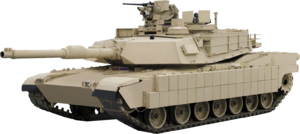 | |
| Type | Main battle tank |
| Place of origin | United States |
| Service history | |
| In service | 1980–present |
| Used by | See Operators below |
| Wars | Gulf War War in Afghanistan Iraq War Iraqi insurgency (2011–present) |
| Production history | |
| Designer | Chrysler Defense (now General Dynamics Land Systems) |
| Designed | 1972–79 |
| Manufacturer | Lima Army Tank Plant (since 1980)[2] Detroit Arsenal Tank Plant (1982–1996) |
| Unit cost | US$6.21 million (M1A2 / FY99)[3] Estimated in 2012 as US$8.58 million (with inflation adjustment) |
| Produced | 1979–present |
| No. built | 10,000[4] |
| Variants | See variants |
| Specifications | |
| Mass | M1: 60 short tons (54 t)[5] M1A1: 63 short tons (57 t)[5] M1A2: 68 short tons (62 t) |
| Length | Gun forward: 32.04 ft (9.77 m)[6] Hull length: 26.02 ft (7.93 m) |
| Width | 12 ft (3.66 m)[6] |
| Height | 8 ft (2.44 m)[6] |
| Crew | 4 (commander, gunner, loader, driver) |
| Armor | M1, M1A1: Burlington composite armor[7] M1A2: depleted uranium mesh-reinforced composite armor[7]
|
Main armament | M1: 105 mm L/52 M68 rifled gun (55 rounds) M1A1: 120 mm L/44 M256A1 smoothbore gun (40 rounds) M1A2: 120 mm L/44 M256A1 smoothbore gun (42 rounds) |
Secondary armament | 1 × .50-caliber (12.7 mm) M2HB heavy machine gun with 900 rounds 2 × 7.62 mm (.308 in) M240 machine guns with 10,400 rounds (1 pintle-mounted, 1 coaxial) |
| Engine | Honeywell AGT1500C multi-fuel turbine engine 1,500 shp (1,120 kW) |
| Power/weight | From 26.9 hp/t (20.05 kW/t) to 23.8 hp/t (17.74 kW/t) |
| Transmission | Allison DDA X-1100-3B |
| Suspension | High-hardness-steel torsion bars with rotary shock absorbers |
| Ground clearance | M1, M1A1: 0.48 m (1 ft 7 in) M1A2: 0.43 m (1 ft 5 in) |
| Fuel capacity | 500 US gallons (1,900 L; 420 imp gal) |
Operational range | M1A2: 426 km (265 mi)[10] |
| Maximum speed | M1A1: Road 45 mph (72 km/h) (governed); Off-road: 30 mph (48 km/h)*[6] M1A2: Road 42 mph (67 km/h) (governed); Off-road: 25 mph (40 km/h)[10] |
The M1 Abrams is an American third-generation main battle tank produced by the United States. It is named after General Creighton Abrams, former Army Chief of Staff and Commander of U.S. military forces in the Vietnam War from 1968 to 1972. Highly mobile, designed for modern armored ground warfare,[11] the M1 is well armed and heavily armored. Notable features include the use of a powerful multifuel turbine engine, the adoption of sophisticated composite armor, and separate ammunition storage in a blow-out compartment for crew safety. Weighing nearly 68 short tons (almost 62 metric tons), it is one of the heaviest main battle tanks in service.
The M1 Abrams entered U.S. service in 1980, replacing the M60 tank.[12] It served for over a decade alongside the improved M60A3, which had entered service in 1978. The M1 remains the principal main battle tank of the United States Army and Marine Corps, and the armies of Egypt, Kuwait, Saudi Arabia, Australia and Iraq.
Three main versions of the M1 Abrams have been deployed, the M1, M1A1, and M1A2, incorporating improved armament, protection and electronics. These improvements and other upgrades to in-service tanks have allowed this long-serving vehicle to remain in front-line service. In addition, development for the improved M1A3 version has been known since 2009.[13][14]
History
The M1 Abrams was developed during the Cold War as a successor to the canceled MBT-70. The M1 Abrams contract went to Chrysler Defense and was the first vehicle to adopt Chobham armor. Adaptations before the Persian Gulf War (Operations Desert Shield and Desert Storm) gave the vehicle better firepower and NBC (Nuclear, Biological and Chemical) protection. Being vastly superior to Iraqi tanks, very few M1 tanks were hit by enemy fire. Upgrades after the war improved the tank's weapons sights and fire control unit. The invasion of Iraq in 2003 destroyed Iraq's military. The subsequent insurgency exposed the tanks' vulnerability to rocket-propelled grenades and mines. These problems were partially rectified with the TUSK modification. The Marine Corps sent a company of M1A1 Abrams to Afghanistan in late 2010.
Development
The first attempt to replace the aging M60 tank was the MBT-70, developed in partnership with West Germany in the 1960s. The MBT-70 had advanced features such as a height-adjustable air suspension and a very small body with the driver in a turret design that allowed the driver to always face the direction of travel. The MBT-70 ultimately proved to be too heavy, complex, and expensive. As a result of the imminent failure of this project, the U.S. Army introduced the XM803, using some technologies from the MBT-70 but removing some of the more troublesome features. This succeeded only in producing an expensive system with capabilities similar to the M60.[15]
Congress canceled the MBT-70 in November and XM803 December 1971, and redistributed the funds to the new XM815, later renamed the XM1 Abrams after General Creighton Abrams. Prototypes were delivered in 1976 by Chrysler Defense and General Motors armed with the license-built version of the 105 mm Royal Ordnance L7 gun along with a Leopard 2 for comparison. The turbine-powered Chrysler Defense design was selected for development as the M1; Chrysler had significant experience designing turbine-powered land vehicles going back to the 1950s. In March 1982, General Dynamics Land Systems Division (GDLS) purchased Chrysler Defense, after Chrysler built over 1,000 M1s.[citation needed]
A total of 3,273 M1 Abrams were produced 1979–85 and first entered U.S. Army service in 1980. Production at the government-owned, GDLS-operated Lima Army Tank Plant in Lima, Ohio, was joined by vehicles built at the Detroit Arsenal Tank Plant in Warren, Michigan from 1982 to 1996.[2] The M1 was armed with the license-built version of the 105 mm Royal Ordnance L7 gun. An improved model called the M1IP was produced briefly in 1984 and contained small upgrades. The M1IP models were used in the Canadian Army Trophy NATO tank gunnery competition in 1985 and 1987.
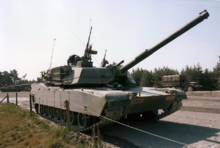
About 6,000 M1A1 Abrams were produced from 1986–92 and featured the M256 120 mm (4.7 in) smoothbore cannon developed by Rheinmetall AG of Germany for the Leopard 2, improved armor, and a CBRN protection system. Production of M1 and M1A1 tanks totaled some 9,000 tanks at a cost of approximately $4.3 million per unit.[16] By 1999, costs for the tank were upwards of US$5 million a vehicle.[3]
In 1990, Project on Government Oversight in a report criticized the M1's high costs and low fuel efficiency in comparison with other tanks of similar power and effectiveness such as the Leopard 2. The report was based on data from U.S. Army sources and the Congressional record.[17]
As the Abrams entered service in the 1980s, they operated alongside M60A3 within the United States military, and with other NATO tanks in numerous Cold War exercises. These exercises usually took place in Western Europe, especially West Germany, but also in some other countries, including South Korea. The exercises were aimed at countering Soviet forces. However, by January 1991 the Berlin Wall had fallen and the Abrams was instead deployed in the Middle East.
Gulf War
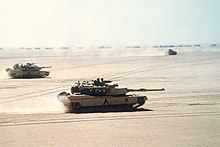
The Abrams remained untested in combat until the Persian Gulf War in 1991, during Operation Desert Storm. A total of 1,848 M1A1s were deployed to Saudi Arabia to participate in the liberation of Kuwait. The M1A1 was superior to Iraq's Soviet-era T-55 and T-62 tanks, as well as T-72 versions imported from the Soviet Union and Poland.[18] The existence of license-produced T-72 (nicknamed Asad Babil) has been disputed; according to Polish officials none were finished prior to the Iraqi Taji tank plant being destroyed in 1991.[18] The T-72s, like most Soviet export designs, lacked night vision systems and then-modern rangefinders, though they did have some night-fighting tanks with older active infrared systems or floodlights. A total of 23 M1A1s were damaged or destroyed during the war. Of the nine Abrams destroyed, seven were destroyed by friendly fire, and two were purposely destroyed to prevent capture after being damaged.[19] Some others took minor combat damage, with little effect on their operational readiness. Very few M1 tanks were hit by enemy fire, which resulted in no fatalities and only a handful of wounded.

The M1A1 was capable of making kills at ranges in excess of 2,500 metres (8,200 ft). This range was crucial in combat against previous generation tanks of Soviet design in Desert Storm, as the effective range of the main gun in the Soviet/Iraqi tanks was less than 2,000 metres (6,600 ft). This meant Abrams tanks could hit Iraqi tanks before the enemy got in range—a decisive advantage in this kind of combat. In friendly fire incidents, the front armor and fore side turret armor survived direct APFSDS hits from other M1A1s. This was not the case for the side armor of the hull and the rear armor of the turret, as both areas were penetrated on at least two occasions by friendly depleted uranium ammunition during the Battle of Norfolk.[20]
During Operations Desert Shield and Desert Storm some M1IP and M1A1s were modified locally in theater by modification work orders (MWO) with additional rolled homogenous armor plating welded on the turret front. The M1 can be equipped with mine plow and mine roller attachments.
Upgrades
The M1A2 was a further improvement of the M1A1 with a commander's independent thermal viewer, weapon station, position navigation equipment, and a full set of controls and displays linked by a digital data bus. These upgrades also provided the M1A2 with an improved fire control system.[21] The M1A2 System Enhancement Package (SEP) added digital maps, FBCB2 capabilities, and an improved cooling system to compensate for heat generated by the additional computer systems. The M1A2 SEP also serves as the basis for the M104 Wolverine heavy assault bridge. The M1A2 SEPv2 (version 2) added Common Remotely Operated Weapon Station (CROWS or CROWS II) support, color displays, better interfaces, a new operating system, better front and side armor, and an upgraded transmission for better durability.[22] Further upgrades included depleted uranium armor for all variants, a system overhaul that returns all A1s to like-new condition (M1A1 AIM), a digital enhancement package for the A1 (M1A1D), and a commonality program to standardize parts between the U.S. Army and the Marine Corps (M1A1HC).
Iraq War
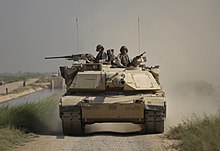
Further combat was seen during 2003 when U.S. forces invaded Iraq and deposed Ba'athist Iraqi leader Saddam Hussein in the Iraq War's Operation Iraqi Freedom. As of March 2005, approximately 80 Abrams tanks were forced out of action by enemy attacks.[23]
The most lopsided achievement of the M1A1s was the destruction of seven T-72s in a point-blank skirmish (less than 50 yards (46 m)) near Mahmoudiyah, about 18 miles (29 km) south of Baghdad, with no losses for the American side.[24] In addition to the Abrams's already heavy armament, some crews were also issued M136 AT4 shoulder-fired anti-tank weapons under the assumption that they might have to engage heavy armor in tight urban areas where the main gun could not be brought to bear.

Following lessons learned in Desert Storm, the Abrams and many other U.S. combat vehicles used in the conflict were fitted with Combat Identification Panels to reduce friendly fire incidents. These were fitted on the sides and rear of the turret, with flat panels equipped with a four-cornered 'box' image on either side of the turret front. Some Abrams were also fitted with a secondary storage bin on the back of the existing bustle rack on the rear of the turret (referred to as a bustle rack extension) to enable the crew to carry more supplies and personal belongings.
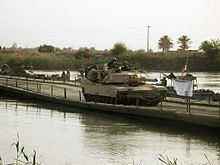
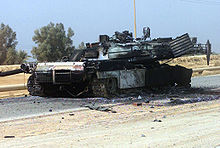
Several Abrams that were irrecoverable due to loss of mobility or other circumstances were destroyed by friendly forces, usually by other Abrams, to prevent their capture.[25] Some Abrams were disabled by Iraqi infantrymen in ambushes during the invasion. Some troops employed short-range anti-tank rockets and fired at the tracks, rear and top. Other tanks were put out of action by engine fires when flammable fuel stored externally in turret racks was hit by small arms fire and spilled into the engine compartment.[26][27] A majority of Abrams damaged (post-invasion) were by improvised explosive devices (IEDs).[28] By December 2006, more than 530 Abrams tanks had been shipped back to the U.S. for repair.[29]
Due to the vulnerability of tanks in urban combat, the Tank Urban Survival Kit (or TUSK) is being issued to some M1 Abrams. It adds protection in the rear and side of the tank to improve fighting ability in urban environments.[30]
In May 2008, it was reported that an American M1 tank had also been damaged by an RPG-29, which uses a tandem-charge high explosive anti-tank warhead to penetrate explosive reactive armor (ERA) as well as composite armor behind it, in Iraq.[31][32] The U.S. considered the RPG-29 threat to American armor high and refused to allow the newly formed Iraqi Army to buy it, fearing that it would fall into the insurgents' hands.[33]
In mid-2014, the Abrams tank saw action in Iraq when the Islamic State launched the June 2014 Northern Iraq offensive. Some Iraqi Army M1A1M tanks were destroyed in fighting against ISIL forces,[34][35]
War in Afghanistan
Operating tanks in Afghanistan can be difficult due to the rough terrain, although Canada and Denmark have deployed Leopard 1 and 2 battle tanks that have been specially modified to operate in the relatively flat and arid conditions of south-western Afghanistan. In late 2010, at the request of Regional Command Southwest, the U.S. Marine Corps deployed a small detachment of 14 M1A1 Abrams from Delta Company, 1st Tank Battalion, 1st Marine Division (Forward),[36] to southern Afghanistan in support of operations in Helmand and Kandahar provinces.[37]
Future
The tracked M8 Armored Gun System was conceived as a possible supplement for the Abrams in U.S. service for low-intensity conflict in the early 1990s. Prototypes were made but the program was canceled. The eight-wheeled M1128 Mobile Gun System was designed to supplement the Abrams in U.S. service for low-intensity conflict.[38] It has been introduced into service and serves with Stryker brigades and Airborne units.
The U.S. Army's Future Combat Systems XM1202 Mounted Combat System was to replace the Abrams in U.S. service and was in development when funding for the program was cut from the DoD's budget.
Engineering Change Proposal 1 is a two-part upgrade process. ECP1A adds space, weight, and entertainment and power improvements and active protection against improvised explosive devices. Nine ECP1A prototypes have been produced as of October 2014. ECP1B, which will begin development in 2015, may include sensor upgrades and the convergence of several tank round capabilities into an multi-purpose round.[39]
The M1A3 Abrams was in the early design period with the U.S. Army in 2009. At that time, the service was seeking a lighter tank version with the same protection as current versions. It aimed to build prototypes by 2014 and begin fielding the first combat-ready M1A3s by 2017.[14][40] Recent program documents suggest that the U.S. Army plans to start the research and development for the M1A3 in 2020.[41]
The M1A2 SEP TUSK Abrams and a modernized M1 Abrams were included in the Ground Combat Vehicle (GCV) Analysis of Alternatives (AOA). Vehicles included in the AOA were determined to be inferior to the planned GCV.[42] The U.S. Army Vice Chief of Staff Gen. Peter Chiarelli commended the M1 Abrams program and recommended a similar approach for the GCV program.[43] The Ground Combat Vehicle family of vehicles was the planned successor to the M1 as well as many other U.S. Army vehicles. However, the Army anticipates that the remaining M1A1 fleet will remain in U.S. service until at least 2021, and the M1A2 to beyond 2050.[44]
Production shutdown
The U.S. Army planned to end production at the Lima Army Tank Plant from 2013 to 2016 in an effort to save over $1 billion; it would be restarted in 2017 to upgrade existing tanks. General Dynamics Land Systems (GDLS), which operates the factory, opposed the move, arguing that suspension of operations would increase long-term costs and reduce flexibility.[45][46] Specifically, GDLS estimated that closing the plant would cost $380 million and restarting production would cost $1.3 billion.[47] If passed, a bill in the U.S. Senate from the first session of the 112th Congress would allocate $272 million in funds toward the plant to allow it to continue regular operations through 2013.[48]
By August 2013, Congress had allocated $181 million for buying parts and upgrading Abrams systems to mitigate industrial base risks and sustain development and production capability. Congress and General Dynamics were criticized for redirecting money to keep production lines open and accused of "forcing the Army to buy tanks it didn't need." General Dynamics asserted that a four-year shutdown would cost $1.1–1.6 billion to reopen the line, depending on the length of the shutdown, whether machinery would be kept operating, and whether the plant's components would be completely removed. They contended that the move was to upgrade Army National Guard units to expand a "pure fleet" and maintain production of identified "irreplaceable" subcomponents; a prolonged shutdown could cause their makers to lose their ability to produce them and foreign tank sales were not guaranteed to keep production lines open. Even though money is being spent to protect the industrial base, some[who?] feel those strategic choices should not be made by members of Congress, especially those with the facilities in their district. There is still risk of production gaps even with production extended through 2015; with funds awarded before recapitalization is needed, budgetary pressures may push planned new upgrades for the Abrams from 2017 to 2019.[49] In December 2014, Congress again allocated $120 million, against the wishes of the Army, for Abrams upgrades including improving gas mileage by integrating an auxiliary power unit to decrease idle time fuel consumption and upgrading the tank's sights and sensors.[50][51]
Design
Countermeasures
Camouflage


Earlier U.S. military vehicles, used from World War II through the Vietnam War, used a scheme of dark brownish green known as "olive drab" with large white stars. Prototypes, early production M1 (105 mm gun) and M1-IP models switched to a flat medium green paint scheme. The large white insignia stars have also transitioned to much smaller black markings. Some units painted their M1s with the older Mobility Equipment Research and Design Command (MERDC) 4-color paint scheme but the turn-in requirements for these tanks required repainting them to solid green. Therefore, even though a large number of the base model M1s were camouflaged in the field, few or none exist today.
M1A1s came from the factory with the NATO three color camouflage Black/Med-Green/Dark-Brown Chemical Agent Resistant Coating (CARC) paint jobs.[citation needed] Today M1A1s are given the NATO three color paint job during rebuilds. M1s and M1A1s deployed to Operation Desert Storm were hastily painted desert tan. Some, but not all, of these tanks were re-painted to their "authorized" paint scheme. M1A2s built for Middle Eastern countries were painted in desert tan. Some M1 series tanks are being painted desert tan for service in Iraq and some are not. Replacement parts (roadwheels, armor skirt panels, drive sprockets, etc.) are painted overall green, which can sometimes lead to vehicles with a patchwork of green and desert tan parts.
Australian M1A1s were desert tan when delivered but have undergone a transition to the Australian Army vehicle standard 'Disruptive Pattern Camouflage'; a scheme that consists of black, olive drab and brown.[52][53]
The U.S. Army can equip its Abrams' with the Saab Group Barracuda camouflage system, which provides concealment against visual, infrared, thermal infrared, and broad-band radar detection.[54]
Concealment
The turret is fitted with two six-barreled smoke grenade launchers (USMC M1A1s use an eight-barreled version). These can create a thick smoke that blocks both vision and thermal imaging. The engine is also equipped with a smoke generator that is triggered by the driver. When activated, fuel is sprayed into the hot turbine exhaust, creating the thick smoke. However, due to the change from diesel as a primary fuel to the use of JP-8, this system is disabled on most Abrams tanks today because of a slightly elevated risk of fire damage to the engine compartment.
Active protection system
In addition to the armor, some Abrams are equipped with a Softkill Active protection system, the AN/VLQ-6 Missile Countermeasure Device (MCD) that can impede the function of guidance systems of some semi-active control line-of-sight (SACLOS) wire- and radio guided anti-tank missiles (such as the Russian 9K114 Shturm) and infrared homing missiles.[55] The MCD works by emitting a massive, condensed infrared signal to confuse the infrared homing seeker of an anti-tank guided missile (ATGM). However, the drawback to the system is that the ATGM is not destroyed, it is merely directed away from its intended target, leaving the missile to detonate elsewhere. This device is mounted on the turret roof in front of the loader's hatch, and can lead some people to mistake Abrams fitted with these devices for the M1A2 version, since the Commander's Independent Thermal Viewer on the latter is mounted in the same place, though the MCD is box-shaped and fixed in place as opposed to cylindrical and rotating like the CITV.
Armor

The Abrams is protected by armor based on the British-designed Chobham armor, a further development of the British 'Burlington' armor. Chobham is a composite armor formed by spacing multiple layers of various alloys of steel, ceramics, plastic composites, and kevlar, giving an estimated maximum (frontal turret) 1,320–1,620 millimetres (52–64 in)[failed verification] of RHAe versus High-explosive anti-tank warhead (and other chemical energy rounds) and 940–960 mm (37–38 in)[failed verification] versus kinetic energy penetrators.[5] It may also be fitted with reactive armor over the track skirts if needed (as in the Urban Survival Kit) and slat armor over the rear of the tank and rear fuel cells to protect against ATGMs. Protection against spalling is provided by a Kevlar liner.
Beginning in 1987, M1A1 tanks received improved armor packages that incorporated depleted uranium (DU) components in their armor at the front of the turret and the front of the hull. Armor reinforced in this manner offers significantly increased resistance towards all types of anti-tank weaponry, but at the expense of adding considerable weight to the tank, as depleted uranium is 1.7 times more dense than lead.[56] The first M1A1 tanks to receive this upgrade were tanks stationed in Germany, since they were the first line of defense against the Soviet Union. US-based tank battalions participating in Operation Desert Storm received an emergency program to upgrade their tanks with depleted uranium armor immediately before the onset of the campaign. M1A2 tanks uniformly incorporate depleted uranium armor, and all M1A1 tanks in active service have been upgraded to this standard as well. The added protection from the depleted uranium armor is believed to be equivalent to 24 inches (610 mm) of RHA. In the Persian Gulf War, Abrams tanks survived multiple hits at relatively close ranges from Iraqi Lion of Babylon tanks and ATGMs. M829A1 "Silver Bullet" APFSDS rounds from other M1A1 Abrams were unable to penetrate the front and side armor (even at close ranges) in friendly fire incidents as well as an incident in which an Abrams tried to destroy an abandoned Abrams stuck in the mud.[57]
Damage control
The tank has a halon firefighting system to automatically extinguish fires in the crew compartment. The engine compartment has a firefighting system that is engaged by pulling a T-handle located on the left side of the tank. The crew compartment also contains small hand-held fire extinguishers. Fuel and ammunition are stored in armored compartments with blowout panels to protect the crew from the risk of the tank's own ammunition cooking off if the tank is damaged — the main gun's ammunition is stored in the rear section of the turret, with blast doors that open under power by sliding sideways only to remove a round for firing, then automatically close.
Armament
Primary
- M68A1 rifled gun
The main armament of the original model M1 was the M68A1 105 mm rifled tank gun firing a variety of high explosive anti-tank, high explosive, white phosphorus and an anti-personnel (multiple flechette) round. This gun is a license-built version of the British Royal Ordnance L7 gun. However, it proved to be inadequate; a cannon with lethality beyond the 3-kilometer (1.9 mi) range was needed to combat newer armor technologies. To attain that lethality, projectile diameter needed to be increased.
- M256 smoothbore gun

The main armament of the M1A1 and M1A2 is the M256A1 120 mm smoothbore gun, designed by Rheinmetall AG of Germany, manufactured under license in the U.S. by Watervliet Arsenal, New York. The M256A1 is a variant of the Rheinmetall 120 mm L/44 gun carried on the German Leopard 2 on all variants up to the Leopard 2A5. Leopard 2A6 replaced the L/44 barrel with a longer L/55.
The M256A1 fires a variety of rounds. The M829A2 APFSDS round was developed specifically to address the improved protection of a Russian T-72, T-80U or T-90 main battle tank equipped with Kontakt-5 Explosive Reactive Armor.[58] Later, the M829A3 APFSDS round was introduced to improve its effectiveness against next generation ERA equipped tanks. As a counter to that, the Russian army introduced Relikt, the most modern Russian ERA, which is claimed to be twice as effective as Kontakt-5.[59] Development of the M829 series is continuing with the M829E4 currently in development.[60] The Abrams also fires High-explosive anti-tank warhead shaped charge rounds such as the M830, the latest version of which (M830A1) incorporates a sophisticated multi-mode electronic sensing fuse and more fragmentation which allows it to be used effectively against armored vehicles, personnel, and low-flying aircraft. The Abrams uses a manual loader. The fourth tank crew member on the Abrams also provides additional support for maintenance, observation post/listening post (OP/LP) operations, and other tasks.
The new M1028 120 mm anti-personnel canister cartridge was brought into service early for use in the aftermath of the 2003 invasion of Iraq. It contains 1,098 3⁄8-inch (9.5 mm) tungsten balls which spread from the muzzle to produce a shotgun effect lethal out to 600 meters (2,000 ft). The tungsten balls can be used to clear enemy dismounts, break up hasty ambush sites in urban areas, clear defiles, stop infantry attacks and counter-attacks and support friendly infantry assaults by providing covering fire. The canister round is also a highly effective breaching round and can level cinder block walls and knock man-sized holes in reinforced concrete walls for infantry raids at distances up to 75 meters (246 ft).[61] Also in use is the M908 obstacle-reduction round. It is designed to destroy obstacles and barriers. The round is a modified M830A1 with the front fuse replaced by a steel nose to penetrate into the obstacle before detonation.[62]
The Army is developing a new round to replace the M830/M830A1, M1028, and M908. Called the Advanced Multi-Purpose (AMP) round, it will have point detonation, delay, and airburst modes through an ammunition data link and a multi-mode, programmable fuse in a single munition. Having one round that does the job of four would simplify logistics and be able to be used on a variety of targets. The AMP is to be effective against bunkers, infantry, light armor, and obstacles out to 500 meters, and will be able to breach reinforced concrete walls and defeat ATGM teams from 500 to 2,000 meters.[63][64]
In addition to these, the XM1111 (Mid-Range-Munition Chemical Energy) was also in development. The XM1111 was a guided munition using a dual-mode seeker that combined imaging-infrared and semi-active laser guidance. The MRM-CE was selected over the competing MRM-KE which used a rocket-assisted kinetic energy penetrator. The CE variant was chosen due to its better effects against secondary targets, providing a more versatile weapon. The Army hoped to achieve IOC with the XM1111 by 2013.[65] However, the Mid-Range Munition was cancelled in 2009 along with Future Combat Systems.[66]
Secondary
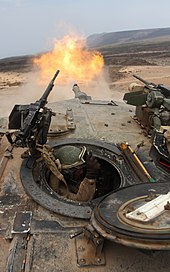
The Abrams tank has three machine guns:
- A .50 cal. (12.7 mm) M2HB machine gun in front of the commander's hatch. On the M1, M1A1, and M1A2 this gun is mounted on the Commander's Weapons Station. This allows the weapon to be aimed and fired from within the tank. With the Common Remote Operated Weapons System (CROWS) add-on kit, an M2A1 .50 Caliber Machinegun, M240, or M249 SAW can be mounted on a CROWS remote weapons platform (similar to the Protector M151 remote weapon station used on the Stryker family of vehicles). Current variants of the TUSK kit on the M1A2 have forgone this, instead adding transparent gun shields to the commander's weapon station. The upgrade variant called the M1A1 Abrams Integrated Management (AIM) equips the .50 caliber gun with a thermal sight for accurate night and other low-visibility shooting.[67]
- A 7.62 mm M240 machine gun in front of the loader's hatch on a skate mount (seen at right). Some of these were fitted with gun shields during the Iraq War, as well as night-vision scopes for low-visibility engagements.
- A second 7.62 mm M240 machine gun in a coaxial mount to the right of the main gun. The coaxial MG is aimed and fired with the same computer fire control system used for the main gun.
- (Optional) A second coaxial 12.7 mm M2HB machine gun can be mounted directly above the main gun in a remote weapons platform as part of the TUSK upgrade kit.
Aiming
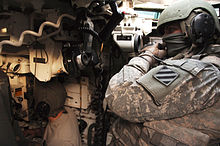
The Abrams is equipped with a ballistic fire-control computer that uses user and system-supplied data from a variety of sources, to compute, display, and incorporate the three components of a ballistic solution—lead angle, ammunition type, and range to the target—to accurately fire the tank. These three components are determined using a YAG rod laser rangefinder, crosswind sensor, a pendulum static cant sensor, data concerning performance and flight characteristics of each specific type of round, tank-specific boresight alignment data, ammunition temperature, air temperature, barometric pressure, a muzzle reference system (MRS) that determines and compensates for barrel drop at the muzzle due to gravitational pull and barrel heating due to firing or sunlight, and target speed determined by tracking rate tachometers in the Gunner's or Commander's Controls Handles. All of these factors are computed into a ballistic solution and updated 30 times per second. The updated solution is displayed in the Gunner's or Tank Commander's field of view in the form of a reticle in both day and Thermal modes. The ballistic computer manipulates the turret and a complex arrangement of mirrors so that all one has to do is keep the reticle on the target and fire to achieve a hit. Proper lead and gun tube elevation are applied to the turret by the computer, greatly simplifying the job of the gunner.[citation needed]

The fire-control system uses this data to compute a firing solution for the gunner. The ballistic solution generated ensures a hit percentage greater than 95 percent at nominal ranges.[citation needed] Either the commander or gunner can fire the main gun. Additionally, the Commander's Independent Thermal Viewer (CITV) on the M1A2 can be used to locate targets and pass them on for the gunner to engage while the commander scans for new targets. In the event of a malfunction or damage to the primary sight system, the main and coaxial weapons can be manually aimed using a telescopic scope boresighted to the main gun known as the Gunner's Auxiliary Sight (GAS). The GAS has two interchangeable reticles; one for High-explosive anti-tank warhead and MPAT (MultiPurpose AntiTank) rounds and one for APFSDS and STAFF (Smart Target-Activated Fire and Forget) ammunition. Turret traverse and main gun elevation can be accomplished with manual handles and cranks in the event of a Fire Control System or Hydraulic System failure. The commander's M2HB .50 caliber machine gun on the M1 and M1A1 is aimed by a 3× magnification sight incorporated into the Commander's Weapon Station (CWS), while the M1A2 uses either the machine gun's own iron sights, or a remote aiming system such as the CROWS system when used as part of the TUSK (Tank Urban Survival Kit). The loader's M240 machine gun is aimed either with the built-in iron sights or with a thermal scope mounted on the machine gun.[citation needed]
Mobility
Tactical
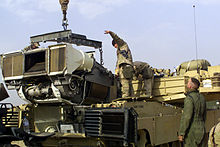
The M1 Abrams's powertrain comprises a 1,500 shaft horsepower (1,100 kW) Honeywell AGT 1500 (originally made by Lycoming) multi-fuel gas turbine, and a six speed (four forward, two reverse) Allison X-1100-3B Hydro-Kinetic automatic transmission, giving it a governed top speed of 45 mph (72 km/h) on paved roads, and 30 mph (48 km/h) cross-country. With the engine governor removed, speeds of around 60 mph (97 km/h) are possible on an improved surface; however, damage to the drivetrain (especially to the tracks) and an increased risk of injuries to the crew can occur at speeds above 45 mph (72 km/h). The tank was built around this engine[68] and it is multifuel capable; meaning that it can be powered with diesel, kerosene, any grade of motor gasoline, and jet fuel (such as JP-4 or JP-8). For logistical reasons, JP-8 is the US military's universal fuel powering both aircraft and vehicle fleets. On the other hand, Australian M1A1 AIM SA burn diesel fuel, since the use of JP-8 is less common in the Australian Army.
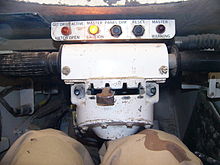
The gas turbine propulsion system has proven quite reliable in practice and combat, but its high fuel consumption is a serious logistic issue (starting up the turbine alone consumes nearly 10 US gallons (38 L) of fuel).[69] The engine burns more than 1.67 US gallons (6.3 L) per mile (60 US gallons (230 L) per hour) when traveling cross-country and 10 US gallons (38 L) per hour when idle.[70] The high speed, high temperature jet blast emitted from the rear of M1 Abrams tanks makes it difficult for the infantry to proceed shadowing the tank in urban combat.[71] The turbine is very quiet when compared to diesel engines of similar power output and produces a significantly different sound from a contemporary diesel tank engine, reducing the audible distance of the sound, thus earning the Abrams the nickname "whispering death" during its first REFORGER exercise.[citation needed]
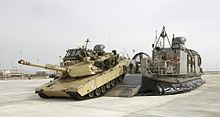
Honeywell was developing another gas turbine engine with General Electric for the XM2001 Crusader program that was to be a replacement for the Abrams's AGT-1500 engine.[72] The new LV100-5 engine was lighter and smaller (43% fewer parts) with rapid acceleration, quieter running, and no visible exhaust.[73] It also featured a 33% reduction in fuel consumption (50% less when idle) and near drop-in replacement.[74] The Abrams-Crusader Common Engine Program was shelved when the Crusader program was canceled, however Phase 2 of Army's PROSE (Partnership for Reduced O&S Costs, Engine) program called for further development of the LV100-5 and replacement of the current AGT-1500 engine.[75]
General Dynamics has been working on a drop-in diesel engine to replace the gas turbine engine. It is smaller than the turbine, 14% cheaper to operate per mile, and has a four-fan cooling system which is to greatly reduce the tank's heat signature.[76] General Dynamics is offering the Tognum America/12V883 diesel engine with new Diehl 570P3 tracks. The engine represents advancements in diesel engine design since the Abrams was first designed, including a common rail fuel injector system where fuel is pressurized and atomized in the cylinder rather than mechanically sprayed. It also has greater torque, an altered nuclear, biological, and chemical protection system that operates independently of the engine, uses less fuel while idle, is quieter, and gives off significantly less heat and pollutants. Incorporating the diesel engine into the Abrams would decrease the operating cost of an armored brigade combat team by 14 percent per mile, increase its operating range from 205 miles to 300+ miles, and use half the amount of fuel on a combat day than the turbine engine. The tracks are a version of the Leopard 2's tracks with different rubber pads and a larger center guide. The improved engine and tracks are not part of an Army upgrade program, but may be included in a near-term engineering change proposal (ECP) phase.[77][78]
Using a high power density 330 cc (20 in3) Wankel rotary engine modified to use diesel and military grade jet fuel, the Army's TARDEC developed a 220-pound (100 kg) Auxiliary Power Unit designed to fit into the M1 Abrams, replacing an existing battery pack that weighs about 500 pounds (230 kg). The new APU will also be more fuel efficient than the tank's main engine.[79] Testing of the first APUs began in 2009.

Although the M1 tank is not designed to carry riders easily, provisions exist for the Abrams to transport troops in tank desant with the turret stabilization device switched off. A battle equipped infantry squad may ride on the rear of the tank, behind the turret. The soldiers can use ropes and equipment straps to provide handholds and snap links to secure themselves. If and when enemy contact is made, the tank conceals itself allowing the infantry to dismount.[80]
Strategic

Strategic mobility is the ability of the tanks of an armed force to arrive in a timely, cost effective, and synchronized fashion. The Abrams can be carried by a C-5 Galaxy or a C-17 Globemaster III. The limited capacity (two combat-ready in a C-5, one combat-ready tank in a C-17) caused serious logistical problems when deploying the tanks for the first Persian Gulf War, though there was enough time for 1,848 tanks to be transported by ship.
Marines transport their Marine Air Ground Task Force (MAGTF)-attached Abrams by combat ship. A Wasp-class Landing Helicopter Dock (LHD) typically carries a platoon of 4 to 5 tanks attached to the deployed Marine Expeditionary Unit, which are then amphibiously transported to shore by Landing Craft Air Cushion (LCAC) at 1 combat-ready tank per landing craft.
The Abrams is also transportable by truck, namely the M1070 Heavy Equipment Transporter (HET). The HET can operate on highways, secondary roads, and cross-country. The HET accommodates the 4 tank crewmen.[81]
The first instance of the Abrams being airlifted directly into a battlefield occurred in April 2003, when armored elements of the 1st Infantry Division were lifted by C-17s into northern Iraq from Ramstein, Germany to support Task Force Viking.[82]
Variants and upgrades
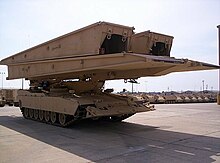

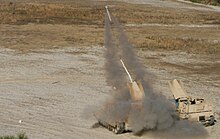
- XM1-FSED: Preproduction test model. Eleven Full-Scale Engineering Development test bed vehicles were produced in 1977–78. These vehicles were also called Pilot Vehicles and were numbered PV-1 through PV-11.
- M1: First production variant. Production began (at Chrysler) in 1979 and continued to 1985 (at General Dynamics) (3,273 built for the US). The first 110 tanks were Low Rate Initial Production (LRIP) models, still called XM1s, because they were built prior to the tank being type-classified as the M1.
- M1IP (Improved Performance): Produced briefly in 1984 before the M1A1, contained upgrades and reconfigurations like new turret with thicker frontal armor, new turret is referred as "long" turret instead of older "short" turret, armor upgraded from ~650mm line of sight thickness to ~880mm (894 build for US).
- M1A1: Production started in 1985 and continued to 1992, pressurized NBC system, rear bustle rack for improved stowage of supplies and crew belongings, redesigned blow-off panels and M256 120 mm smoothbore cannon (4,976 built for the U.S. Army, 221 for USMC, 755 for Egypt, 59 M1A1 AIM SA sold to Australia).
- M1A1HA (Heavy Armor): Added 1st generation depleted uranium armor components. Some tanks were later upgraded with 2nd generation depleted uranium armor components, and are unofficially designated M1A1HA+.
- M1A1HC (Heavy Common): Added new 2nd generation depleted uranium armor components, digital engine control and other small upgrades common between Army and Marine Corps tanks.
- M1A1D (Digital): A digital upgrade for the M1A1HC, to keep up with M1A2SEP, manufactured in quantity for only 2 battalions.
- M1A1AIM v.1 (Abrams Integrated Management): A program whereby older units are reconditioned to zero hour conditions;[83] and the tank is improved by adding Forward-Looking Infra-Red (FLIR) and Far Target Locate sensors, a tank-infantry phone, communications gear, including FBCB2 and Blue Force Tracking, to aid in crew situational awareness, and a thermal sight for the .50 caliber machine gun. General Dynamics has been awarded contracts by the U.S. Army to supply this variant.[67]
- M1A1AIM v.2/M1A1SA (Situational Awareness): Upgrades similar to AIM v.1 tanks + new 3rd generation depleted uranium armor components.
- M1A1FEP (Firepower Enhancement Package): Similar upgrade to AIM v.2 for USMC tanks.
- M1A1KVT (Krasnovian Variant Tank): M1A1s that have been visually modified to resemble Soviet-made tanks for use at the National Training Center, fitted with MILES gear and a Hoffman device.
- M1A1M: An export variant ordered by the Iraqi Army.[84]
- M1A1SA (Special Armor): configuration for the Royal Moroccan Army.[85]
- M1A2 (Baseline): Production began in 1992 (77 built for the US and more than 600 M1s upgraded to M1A2, 315 for Saudi Arabia, 218 for Kuwait). The M1A2 offers the tank commander an independent thermal sight and ability to, in rapid sequence, shoot at two targets without the need to acquire each one sequentially, also 2nd generation depleted uranium armor components.[86]
- M1A2SEP (System Enhancement Package): Has upgraded third-generation depleted uranium armor components with graphite coating (240 new built, 300 M1A2s upgraded to M1A2SEP for the USA, also unknown numbers of upgraded basic M1s and M1IPs, also 400 oldest M1A1s upgraded to M1A2SEP).
- M1A3: Under development, with development planned to start by 2020.[87][88] Improvements are to include a lighter 120 mm gun, added road wheels with improved suspension, a more durable track, lighter armor, long-range precision armaments, and infrared camera and laser detectors. A new internal computer system is also desired, with current wiring replaced by fiber-optic lines that could decrease weight by some two tons.[89]
- M1 TTB (Tank Test Bed): Prototype with unmanned turret, 3 crew members in armored capsule in front of the heavy armored hull, main armament was 120 mm smoothbore gun, M256 derivative or modification, mechanical loading system under turret, never fielded.
- CATTB – Experimental model with a 140 mm smoothbore gun, heavy armored turret and upgraded hull based on the M1's chassis. It had a mechanical loading system in turret bustle, a new engine and probably other upgrades, never fielded. The tank went trials in 1987–1988. CATTB stands for Component Advanced Technology Test Bed.[90]
- M1 Grizzly Combat Mobility Vehicle (CMV)[91][92]
- M1 Panther II Remote Controlled Mine Clearing Vehicle[93]
- M104 Wolverine Heavy Assault Bridge[94]
- M1 Panther II Mine Clearing Blade/Roller System.
- M1 Assault Breacher Vehicle: Assault variant for the USMC. Based upon the M1A1 Abrams chassis, the Assault Breacher Vehicle has a variety of systems installed, such as a full-width mine plow, two linear demolition charges, and a lane-marking system. Reactive armor has been fitted to the vehicle providing additional protection against High-explosive anti-tank warhead-based weapons. The turret has been replaced by a new smaller one with two MICLIC launchers at its rear. A M2HB .50 machine gun in a remote weapons station is mounted on the commander's cupola and a bank of grenade launchers are fitted to each side of the superstructure to cover the frontal arc are provided for self-protection.[95][96]
- M1 Armored Recovery Vehicle. Only a prototype produced.
Specifications
| M1 | M1IP | M1A1 | M1A2 | M1A2SEP | |
|---|---|---|---|---|---|
| Produced | 1979–85 | 1984 | 1986–92 | 1992 on | |
| Length | 32.04 ft (9.77 m) | ||||
| Width | 12 ft (3.7 m) | ||||
| Height | 7.79 ft (2.37 m) | 8.0 ft (2.4 m) | |||
| Top speed | 45 mph (72 km/h) | 41.5 mph (66.8 km/h) | 42 mph (68 km/h) | ||
| Range | 310 mi (500 km) | 288 mi (463 km) | 243 mi (391 km) | ||
| Weight | 61.4 short tons (55.7 t) | 62.8 short tons (57.0 t) | 67.6 short tons (61.3 t) | 68.4 short tons (62.1 t) | 69.5 short tons (63.0 t) |
| Main armament | 105 mm M68 rifled | 120 mm M256 smoothbore | |||
| Crew | 4 (commander, gunner, loader, driver) | ||||
Note: All of the above produce a power of 1,500 shp (1,100 kW).
Tank Urban Survival Kit
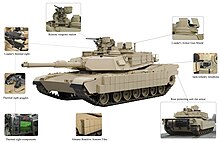

The Tank Urban Survival Kit (TUSK) is a series of improvements to the M1 Abrams intended to improve fighting ability in urban environments.Cite error: The <ref> tag has too many names (see the help page). Historically, urban and other close battlefields have been the worst place for tanks to fight. A tank's front armor is much stronger than that on the sides, top, or rear. In an urban environment, attacks can come from any direction, and attackers can get close enough to reliably hit weak points in the tank's armor or gain sufficient elevation to hit the top armor.
Armor upgrades include reactive armor on the sides of the tank and slat armor (similar to that on the Stryker) on the rear to protect against rocket-propelled grenades and other shaped charge warheads. A Transparent Armor Gun Shield and a thermal sight system are added to the loader's top-mounted M240B 7.62 mm machine gun, and a Kongsberg Gruppen Remote Weapon Turret carrying a .50 caliber machine gun (again similar to that used on the Stryker) is in place of the tank commander's original .50 caliber machine gun mount, wherein the commander had to expose himself to fire the weapon manually. An exterior telephone allows supporting infantry to communicate with the tank commander.
The TUSK system is a field-installable kit that allows tanks to be upgraded without needing to be recalled to a maintenance depot. While the reactive armor may not be needed in most situations, in maneuver warfare, items like the rear slat armor, loader's gun shield, infantry phone (which saw use on Marine Corps M1A1s as early as 2003), and Kongsberg Remote Weapons Station for the .50 in caliber machine gun will be added to the entire M1A2 fleet over time.
On 29 August 2006, General Dynamics Land Systems received a U.S. Army order for 505 Tank Urban Survivability Kits (TUSK) for Abrams main battle tanks supporting operations in Iraq, under a US$45 million contract. Deliveries were expected to be completed by April 2009.[97] Under a separate order, the U.S. Army awarded General Dynamics Armament and Technical Products (GDATP) US$30 million to produce reactive armor kits to equip M1A2s. The reactive tiles for the M1 will be locally produced at GDATP's Burlington Technology Center. Tiles will be produced at the company's reactive armor facility in Stone County Operations, McHenry, Mississippi. On 8 December 2006, the U.S. Army added Counter Improvised Explosive Device enhancements to the M1A1 and M1A2 TUSK, awarding GDLS $11.3 million contract, part of the $59 million package mentioned above. In December, GDLS also received an order, amounting to around 40% of a US$48 million order, for loader's thermal weapon sights being part of the TUSK system improvements for the M1A1 and M1A2 Abrams Tanks.[97]
Operators
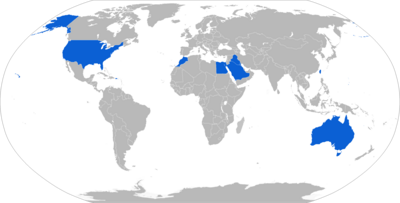



 Australia – Australian Army: 59 M1A1 (AIM) configuration tanks (hybrids with a mix of equipment used by U.S. Army and U.S. Marine Corps but without depleted uranium layers in armor). These tanks were bought from the U.S. in 2006 and replaced the Leopard AS1 in 2007.[98]
Australia – Australian Army: 59 M1A1 (AIM) configuration tanks (hybrids with a mix of equipment used by U.S. Army and U.S. Marine Corps but without depleted uranium layers in armor). These tanks were bought from the U.S. in 2006 and replaced the Leopard AS1 in 2007.[98] Egypt – Egyptian Army: 1,005 M1A1 tanks co-produced by the U.S. and Egypt for the Egyptian army. Another 200 tanks have been ordered.[99]
Egypt – Egyptian Army: 1,005 M1A1 tanks co-produced by the U.S. and Egypt for the Egyptian army. Another 200 tanks have been ordered.[99] Iraq – Iraqi Army: 140 M1A1Ms (without depleted uranium layers in armor). Iraq was leasing 22 U.S. Army M1A1s for training in 2008.[84][100][101][102] The first 11 tanks were delivered to the Iraqi Army in August 2010.[103] All were delivered by August 2011.[104] In October 2012, it was reported that six more tanks were being delivered.[105] More than 40 Iraqi Army Abrams tanks had been captured by Islamic State of Iraq and the Levant as of June 2015.[106]
Iraq – Iraqi Army: 140 M1A1Ms (without depleted uranium layers in armor). Iraq was leasing 22 U.S. Army M1A1s for training in 2008.[84][100][101][102] The first 11 tanks were delivered to the Iraqi Army in August 2010.[103] All were delivered by August 2011.[104] In October 2012, it was reported that six more tanks were being delivered.[105] More than 40 Iraqi Army Abrams tanks had been captured by Islamic State of Iraq and the Levant as of June 2015.[106] Kuwait – Kuwaiti Army: 218 M1A2s (without depleted uranium layers in armor)[107]
Kuwait – Kuwaiti Army: 218 M1A2s (without depleted uranium layers in armor)[107] Saudi Arabia – Saudi Arabian Army: 373 Abrams tanks,[108] To be upgraded to M1A2S configuration in Saudi Arabia.[108] 69 more M1A2S tanks ordered on 8 January 2013, to be delivered by 31 July 2014.[109]
Saudi Arabia – Saudi Arabian Army: 373 Abrams tanks,[108] To be upgraded to M1A2S configuration in Saudi Arabia.[108] 69 more M1A2S tanks ordered on 8 January 2013, to be delivered by 31 July 2014.[109] United States – United States Army and United States Marine Corps have received over 8,100 M1, M1A1 and M1A2 tanks combined.[110][111]
United States – United States Army and United States Marine Corps have received over 8,100 M1, M1A1 and M1A2 tanks combined.[110][111]
|
Potential operators
 Greece – Hellenic Army: 400 ex-U.S. Army M1A1 tanks have been offered to Greece, from which 90 might be procured.[112][113][114]
Greece – Hellenic Army: 400 ex-U.S. Army M1A1 tanks have been offered to Greece, from which 90 might be procured.[112][113][114] Morocco – Royal Moroccan Army: 200 excess M1A1s were requested in 2011. The U.S. DSCA notified Congress of a possible Foreign Military Sale for upgrades in June 2012. The proposed sale is for enhancement to Abrams tanks to the Special Armor (SA) configuration, refurbishment of Abrams tanks, and associated parts.[115][116]
Morocco – Royal Moroccan Army: 200 excess M1A1s were requested in 2011. The U.S. DSCA notified Congress of a possible Foreign Military Sale for upgrades in June 2012. The proposed sale is for enhancement to Abrams tanks to the Special Armor (SA) configuration, refurbishment of Abrams tanks, and associated parts.[115][116] Peru – Peruvian Army: In May 2013, the M1A1 Abrams was reported to be part of comparative tests to be conducted by Peru to find a replacement for their aging T-55s. Between 120 and 170 tanks may be acquired. The Abrams competed against the T-90S, Leopard 2A4 and A6, T-64, and T-84. By September 2013, only the M1A1 Abrams, Russian T-90S and T-80, and Ukrainian T-84 were still competing.[117]
Peru – Peruvian Army: In May 2013, the M1A1 Abrams was reported to be part of comparative tests to be conducted by Peru to find a replacement for their aging T-55s. Between 120 and 170 tanks may be acquired. The Abrams competed against the T-90S, Leopard 2A4 and A6, T-64, and T-84. By September 2013, only the M1A1 Abrams, Russian T-90S and T-80, and Ukrainian T-84 were still competing.[117] Taiwan – Republic of China Army: According to a report, the Taiwanese government is considering placing an order for 200 used M1A1s from the U.S.[118]
Taiwan – Republic of China Army: According to a report, the Taiwanese government is considering placing an order for 200 used M1A1s from the U.S.[118]
See also
Tanks of comparable role, performance and era
- Challenger 2: British main battle tank
- Leopard 2: German main battle tank
- Merkava: Israeli main battle tank
- T-80: Russian main battle tank
- T-90: Russian main battle tank
- Type 99: Chinese main battle tank
- Oplot-M: Ukrainian main battle tank
References
- Footnotes
- ^ In M1 Abrams Main Battle Tank 1982–1992 Steven J. Zaloga writes that "[t]he new armour reportedly gives the M1A1HA the equivalent of 1,300 mm steel armour against shaped charge warheads and 600 mm against APFSDS,..." (page 11), which is at least partial a contradiction to what he wrote in T-72 Ural vs M1 Abrams. On page 27 is a chart where the frontal turret armor of the M1A1HA is claimed to be equivalent to 800 mm steel armor (RHA).
- Citations
- ^ "PROTECTOR Remote Weapon Station". Kongsberg Protech Systems. Retrieved 4 October 2013.
- ^ a b John Pike. "Lima Army Tank Plant (LATP)". Globalsecurity.org. Retrieved 30 June 2010.
- ^ a b "Department of Defense – Annual Report FY99". Retrieved 20 February 2014.
- ^ http://www.deagel.com/Main-Battle-Tanks/M1A3-Abrams_a000516005.aspx
- ^ a b c R.P. Hunnicutt, Abrams: A History of the American Main Battle Tank
- ^ a b c d "Abrams fact file". U.S. Army. Archived from the original on 23 April 2015.
{{cite web}}: Unknown parameter|deadurl=ignored (|url-status=suggested) (help) Cite error: The named reference "factfile" was defined multiple times with different content (see the help page). - ^ a b Zaloga, Steven J.; Sarson, Peter (1993). M1 Abrams Main Battle Tank 1982–92. p. 6. ISBN 978-1-85532-283-7. Cite error: The named reference "Steven" was defined multiple times with different content (see the help page).
- ^ a b c Zaloga., Steven J. (10 August 2009). T-72 Ural vs M1 Abrams. Osprey Publishing. p. 15. ISBN 978-1-84603-407-7. Author mentions that a Soviet report estimated the protection of the basic M1 to be equivalent to 470 mm steel armor against armor-piercing rounds and equivalent to 650 mm steel armor against shaped charge warheads. Cite error: The named reference "T-72vsM1" was defined multiple times with different content (see the help page).
- ^ Zaloga, Steven J.; Sarson, Peter (1993). M1 Abrams Main Battle Tank 1982–92. p. 11. ISBN 978-1-85532-283-7.
- ^ a b Foss, Chris. Jane's Armour and Artillery 2005–2006. Jane's Information Group. p. 162. ISBN 0-7106-2686-X.
- ^ M1 Abrams Main Battle tank. FAS.org, 14 April 2000.
- ^ Hunnicutt 1984, pp. 6, 149, 408.
- ^ http://www.g8.army.mil/pdf/Army_Equipment_Program2015.pdf
- ^ a b Osborn, Kris (26 September 2009). "Army looking into lighter Abrams tank". Army Times. Retrieved 31 December 2013.
- ^ John Pike (13 May 2010). "MBT-70 / XM803". Globalsecurity.org. Retrieved 30 June 2010.
- ^ Pike, John. "Lima Army Tank Plant (LATP)". Globalsecurity.org. Retrieved 20 February 2014.
- ^ "The Army's M1 Tank: Has It Lived Up To Expectations?". Project on Government Oversight. 1 January 1990. Template:Wayback
- ^ a b Steven J. Zaloga & Peter Sarson (1993), p. 24
- ^ GAO/NSIAD-92-94, "Operation Desert Storm: Early performance assessment of Bradleys and Abrams", p. 24. GAO, January 1992. Quote: "According to the Army's Office of Deputy Chief of Staff for Operations and Plans, 23 Abrams tanks were destroyed or damaged in the Persian Gulf area. Of the nine Abrams destroyed, seven were due to friendly fire, and two were intentionally destroyed to prevent capture after they became disabled. Other Abrams tanks were damaged by enemy fire, land mines, on-board fires, or to prevent capture after they became disabled."
- ^ "A Company, 3–66 Armor, Abrams (Bumper # A-33)". TAB H – Friendly-fire Incidents.
At approximately 4:30 AM on 27 February, an anti-tank guided missile (probably fired from a Bradley) struck A-33 in the engine compartment. The crew, uninjured, was evacuating the disabled tank when two DU rounds hit the tank in the left side of the hull and exited through the right side. The tank commander, driver, and gunner sustained injuries from fragments. The loader, who was already outside the tank, was uninjured. A-31 crew members assisted in rescuing A-33's crew.
; Sketch depicting the path of a DU 120 mm round through the hull of Abrams C-12. OSD. - ^ Diaz, R. Gary. "Intervehicular Information System (IVIS): The Basis for a Tactical Information System", SAE Paper Number: 940982, General Dynamics, 1 March 1994.
- ^ https://fas.org/man/dod-101/sys/land/wsh2013/12.pdf
- ^ Komarow, Steven. "Tanks take a beating in Iraq". USA Today, 29 March 2005.
- ^ Conroy, Jason & Martz, Ron. Heavy Metal: A Tank Company's Battle To Baghdad. Potomac Books, 2005, p. 158.
- ^ Zucchino, David: Thunder Run: The Armored Strike to Capture Baghdad. Grove Press, 2004, pp. 20–30, 73.
- ^ "Technical Intelligence Bulletins". Wlhoward.com. May–June 2003. Archived from the original on 12 March 2007.
- ^ Conway, John P. (7 January 2004). "Abrams Tank Systems: Lessons Learned Operation Iraqi Freedom" (PDF).
- ^ "Youtube: M1A2 Abrams struck by Vehicle-Borne IED". Retrieved 10 September 2010.
- ^ "U.S. Army Battling To Save Equipment". Washington Post. Retrieved 11 October 2014.
- ^ Komarow, Steven. "Tanks adapted for urban fights they once avoided". USA Today, 29 March 2005.
- ^ Michael R. Gordon (21 May 2008). "Operation in Sadr City Is an Iraqi Success, So Far". The New York Times.
- ^ RPG-29 vs M1A2. LiveLeak.com
- ^ "Super RPG threat, Army passes on system that could defeat RPG-29, DoD officials say". ArmyTimes.[dead link]
- ^ "Iraqi Abrams losses revealed". Retrieved 13 February 2015.
- ^ "Islamic State photos detail rout of Iraqi Army at Camp Saqlawiya". Retrieved 13 February 2015.
- ^ Marine tanks prepare for their first missions in Afghanistan. U.S. Marine Corps, 18 January 2011. Template:Wayback
- ^ U.S. Tanks En Route to Southwestern Afghanistan. American Forces Press Service, 19 November 2010. Retrieved 12 March 2011.
- ^ Asia-Pacific defence reporter, Volume 30. Asia-Pacific Defence Publications. 2004. Retrieved 2 April 2011.
- ^ Wasserbly, Daniel (14 October 2014). "AUSA 2014: Army outlines upcoming combat vehicle choices". IHS Jane's International Defence Review.
ECP1A for Abrams, which just completed a 'critical design review', and includes design efforts to incorporate data links for future ammunition, increased protection, as well as on-board diagnostics and a shift from line replaceable units (LRUs) to line replaceable modules (LRMs). LRMs are easier to replace because there are fewer cables, boxes, and cards to handle.
- ^ "New Army tank could mean changes for M1A1 fleet". MarineCorpsTimes.com. 30 September 2009. Retrieved 31 December 2013.
- ^ http://www.g8.army.mil/pdf/Army_Equipment_Program2015.pdf
- ^ "Army Evaluated Nine Vehicles Against GCV In Analysis Of Alternatives". Inside Washington Publisher. January 2010. Retrieved 12 January 2011.
- ^ Paul McLeary (25 February 2011). "Abrams is Model for Army Infantry Carrier". The McGraw-Hill Companies, Inc. Archived from the original on 18 May 2015. Retrieved 25 February 2011.
{{cite news}}: Unknown parameter|deadurl=ignored (|url-status=suggested) (help) - ^ "General Dynamics Land Systems M1/M1A1/M1A2 Abrams MBT (United States), MBTs and medium tanks". Jane's Armour and Artillery. Jane's Information Group. Retrieved 1 July 2011Template:Inconsistent citations
{{cite journal}}: CS1 maint: postscript (link) - ^ Ewing, Philip (21 April 2011). "The tank at the end of history". DoD Buzz. Military.com. Retrieved 23 April 2011.
- ^ "Support Abrams". General Dynamic Land Systems. Retrieved 23 April 2011.
{{cite journal}}: Cite journal requires|journal=(help) - ^ "Lighter, Yet Deadlier". Gannett Government Media Corporation. Retrieved 24 July 2011.
{{cite journal}}: Cite journal requires|journal=(help) - ^ Ellen Mitchell (15 July 2011). "House OKs additional funds so General Dynamics can keep building Abrams tanks". Crain Communications Inc. Retrieved 16 November 2013.
- ^ "Over Army Objections, Industry and Congress Partner to Keep Abrams Tank Production 'Hot'". National Defense Magazine, October 2013.
- ^ New $120 million upgrade program for the U.S. M1 Abrams main battle tank – Armyrecognition.com, 12 December 2014
- ^ Congress Again Buys Abrams Tanks the Army Doesn't Want – Military.com, 18 December 2014
- ^ Miller, Jason. "Australian Military Vehicles Research -Disruptive Pattern Camouflage for the Australian Abrams M1A1 AIM SA (as at 2010)". Mheaust.com.au. Retrieved 28 June 2011.[self-published source?]
- ^ Australian Government, Department of Defence (13 May 2010). "Exercise Chong Ju – Desert tan vs Auscam Abrams". Defence.gov.au. Retrieved 28 June 2011.
- ^ U.S. Army Orders Saab Barracuda Camouflage Solutions - Armyrecognition.com, 12 June 2015
- ^ "Defense Update.com". Defense Update.com. 25 April 2006. Retrieved 9 June 2009.
- ^ "BBC: US to use depleted uranium". BBC News. 18 March 2003. Retrieved 9 June 2009.
- ^ Clancy, Tom: Armored Cav: A Guided Tour of an Armored Cavalry Regiment. Berkeley Books, 1994, p. 58.
- ^ Fabio Prado. "Main Battle Tank – M1, M1A1, and M1A2 Abrams". Fprado.com. Retrieved 28 June 2011.
- ^ "Internet Archive Wayback Machine". Web.archive.org. 24 February 2008. Archived from the original on 24 February 2008. Retrieved 28 June 2011.
{{cite web}}: Cite uses generic title (help) - ^ "Next-Gen 120 mm Tank Killer: ATK's M829E4 AKE". Defense Industry Daily.
- ^ Hilmes (2004), p. 79.
- ^ "M908 HE-OR-T". ATK.com
- ^ http://www.dtic.mil/ndia/2012armaments/TuesdayPaulHill.pdf
- ^ Army developing new 120 mm AMP tank round – Army.mil, 19 March 2014
- ^ "Clank Softly and Carry a Better Shillelagh". Defense Industry Daily.
- ^ "MRM cancelled". Soldiergeek.com, 11 July 2011.
- ^ a b "General Dynamics Awarded $34 Million for M1A1 Abrams Tank Upgrades" (Press release). General Dynamics. 5 September 2008.
- ^ "Heavy duty: overhaul under way for Abrams tank engine". Accessmylibrary.com. 1 September 2006. Archived from the original on 11 January 2009. Retrieved 9 June 2009.
{{cite web}}: Unknown parameter|deadurl=ignored (|url-status=suggested) (help) - ^ Fabio Prado. "Main Battle Tank – M1, M1A1, and M1A2 Abrams". 64.26.50.215. Archived from the original on 29 September 2007. Retrieved 9 June 2009.
{{cite web}}: Unknown parameter|deadurl=ignored (|url-status=suggested) (help) - ^ John Pike. "M1 Abrams Main Battle Tank -Specifications". Globalsecurity.org. Retrieved 6 July 2011.
- ^ "FM 3-06-11, Chapter 7, section C-1". United States military.
The extreme heat produced immediately to the rear of the M1-series tanks prevents dismounted infantry from following closely...
- ^ "GE Press Release: GE and Honeywell Begin Testing of LV100-5 Engine For Abrams-Crusader Common Engine Program". Geae.com. 27 August 2001. Retrieved 9 June 2009.
- ^ Template:Wayback[dead link]
- ^ Template:Wayback[dead link]
- ^ 2 May 2005 04:18 EDT (2 May 2005). "AIM Program's M1A1 Tank Refits and Rebuilds Continue". Defenseindustrydaily.com. Retrieved 9 June 2009.
{{cite web}}: CS1 maint: numeric names: authors list (link) - ^ "Diesel M1 engine". Nationaldefensemagazine.com, January 2013. Retrieved: 17 December 2012.
- ^ Abrams Dieselization Project: A Modest Proposal – Defensemedianetwork.com, 5 November 2013
- ^ Abrams Dieselization Project: Doing the Math – Defensemedianetwork.com, 7 November 2013
- ^ "TARDEC Auxiliary Power Unit for a tank". Engineeringtv.com. Retrieved 9 June 2009.
- ^ Department of the Army (2009). "7". U.S. Army Warrior Ethos And Combat Skills Handbook (Field Manual No. 3‑21.75). Morris Book Publishing, LLC. ISBN 978-1-59921-819-9. Retrieved 2 June 2010.
{{cite book}}: External link in|chapterurl=|chapterurl=ignored (|chapter-url=suggested) (help) - ^ "M1070 Heavy Equipment Transporter (HET) Fact File United States Army". Army.mil. Retrieved 30 June 2010.
- ^ Anderson, Jon R. (10 April 2003). "1st ID task force's tanks deployed to northern Iraq". Stars and Stripes. Retrieved 8 June 2011.
- ^ "M1 Abrams Main Battle Tank". Fas.org. Retrieved 30 June 2010.
- ^ a b "Armor: Iraq Getting M-1A1 Tanks". Strategypage.com. 3 August 2008. Retrieved 9 June 2009.
- ^ [1] Template:Wayback
- ^ M1 Abrams Main Battle Tank. Federation of American Scientists
- ^ http://www.g8.army.mil/pdf/Army_Equipment_Program2015.pdf
- ^ "Army looking into lighter Abrams tank". Army Times. 28 September 2009. Retrieved 21 December 2010.
- ^ "The Abrams Tank – Next Generation". About.com
- ^ "CATTB data". Retrieved 28 June 2011.
- ^ John Pike. "Grizzly [Breacher]". Globalsecurity.org. Retrieved 30 June 2010.
- ^ [2] Template:Wayback
- ^ John Pike. "Panther". Globalsecurity.org. Retrieved 30 June 2010.
- ^ John Pike. "Wolverine (Heavy Assault Bridge)". Globalsecurity.org. Retrieved 30 June 2010.
- ^ "ABV Assault Breacher Vehicle engineer armoured vehicle tank". Retrieved 5 February 2010.
- ^ Abramson,Mark, "ABVs ready to break Afghan ground", Stars and Stripes, 1 February 2010.
- ^ a b "Tank Urban Survivability Kit (TUSK)". Retrieved 11 October 2014.
- ^ "Acquisition of the ABRAMS Main Battle Tank". Australian National Audit Office. 17 July 2007. Retrieved 6 May 2014.
- ^ [3] Template:Wayback
- ^ "Procurement: Iraq Buys What It Knows". Strategypage.com. 18 December 2008. Retrieved 9 June 2009.
- ^ "Iraqi military plans major arms purchase". Your Defence News, 16 December 2008.
- ^ M1 Abrams Tanks for Iraq. Defense Industry Daily, 15 March 2009.
- ^ Agence France-Presse (9 August 2010). "Iraq takes delivery of American tanks". defencetalk.comTemplate:Inconsistent citations
{{cite web}}: CS1 maint: postscript (link) - ^ "Iraqi Army receives last shipment of Abrams tanks". Army.mil, 6 September 2011.
- ^ "6 more tanks". Defenseindustrydaily.com, 5 October 2012.
- ^ Peter Van Buren (2 June 2015). "Hezbollah Brigades flaunts US equipment in Anbar operation". Reuters. Retrieved 15 July 2015.
- ^ M1 Abrams. Militarium.net
- ^ a b "The 2006 Saudi Shopping Spree: $2.9B to Upgrade M1 Abrams Tank Fleet". DefenseIndustryDaily.com. 4 January 2011. Archived from the original on 7 June 2011. Retrieved 28 July 2011.
{{cite web}}: Unknown parameter|deadurl=ignored (|url-status=suggested) (help) - ^ "Saudi Arabia Orders 69 More M1A2S Abrams Heavy Tanks". Deagel.com, 8 January 2013.
- ^ Fabio Prado (10 December 2009). "Main Battle Tank – M1, M1A1, and M1A2 Abrams". Armorsite. Retrieved 9 June 2009.
- ^ a b c d Pike, John (16 January). "M1 Abrams Main Battle Tank". Globalsecurity.org. Retrieved 1 May 2014.
{{cite web}}: Check date values in:|date=(help) - ^ Ζητήστε μας ό,τι σας χρειάζεται (in Greek). Kathimerini. n.d. Retrieved 9 April 2012.
- ^ Agence France-Presse "Greece Considers Free Tank Offer". Defense News, 7 December 2011. Retrieved: 18 April 2012.
- ^ "Πέντε C 130 και 100 άρματα μάχης Abrams "έρχονται" από ΗΠΑ". onalert.gr. Retrieved 1 April 2015.
- ^ Template:Wayback. US DSCA,
- ^ Large Scale Tanks. armyrecognition.com
- ^ Peru; Future main battle tank projects lags on despite criticism. Dmilt.com, 2 September 2013.
- ^ "Taiwan mulls buying used US tanks". AFP. 23 July 2012. Retrieved 23 July 2012.
- Bibliography
- Orr, Kelly. King of the Killing Zone. W.W. Norton Company, 1989.
- Rostker, Bernard (1998). "Environmental Exposure Report: Depleted Uranium in the Persian Gulf (II)". DoD Publication, gulflink.osd.mil. Retrieved 30 June 2010.
- United States General Accounting Office:Operation Desert Storm: Early Performance Assessment of Bradley and Abrams. Washington, January 1992.PDF.
- Halberstadt, Hans. Desert Storm Ground War. Osceola, WI: Motorbooks International, 1991. 128 pp.
- Hilmes, Rolf (1 December 2004). "Arming Future MBTs – Some Considerations". Military Technology. Mönsch.
- Hunnicutt, R.P. "Patton: A History of the American Main Battle Tank". Presidio Press, 1984 ISBN 0-89141-230-1.
- Forty, George: Tank Action. From the Great War to the Persian Gulf, Allan Sutton Publishing Ltd., Phoenix Mill 1995.
- Zaloga Steven J., & Sarson, Peter. M1 Abrams Main Battle Tank 1982–1992. Osprey Military, New Vanguard. Reed International Books Ltd, 1993.
- "M1 Abrams Main Battle Tank". FAS Military Analysis Network. Retrieved 17 January 2004.
- "TUSK to update Abrams for urban battle". Army News Service. Archived from the original on 16 March 2005. Retrieved 6 April 2005.
- Army Times – Two soldiers die in attack on Abrams tank, October 29, 2003[dead link]
- Practical Applications of Vehicle Control within the Distributed Processing Architecture, Proceedings of the 1992 American Control Conference, Ruggirello, Joseph A., Bielawski, Dennis A., and Diaz, R. Gary, General Dynamics, IEEE, Published Jun. 1992
External links
- The Abrams is back - the419
- M1A2 on Armour.ws
- Abrams U.S. Army Fact File
- M1A1/2 Abrams page on the Armor Site
- Main Battle Tank M1A1 Abrams on Enemyforces.com
- M1 Abrams page, with a detailed overview of how the tank works on howstuffworks.com
- M1 Tank Urban Survivability Kit (TUSK), M1A1 AIM Upgrade, and M1A2 SEP Upgrade on Defense-Update.com
- M1 Abrams Main Battle Tank page on GlobalSecurity.org
- M1A1 main battle tank on armyrecognition.com
- AGT1500 Turbine Technology on Honeywell.com
- M1 Abrams Tanks for Iraq
- M1 Abrams modernisation 2011
- M1 Abrams modernisation 2012

